Category: Art & Culture
Pushkaralu Festival returns to the Ganga after 12 years
25, Apr 2023
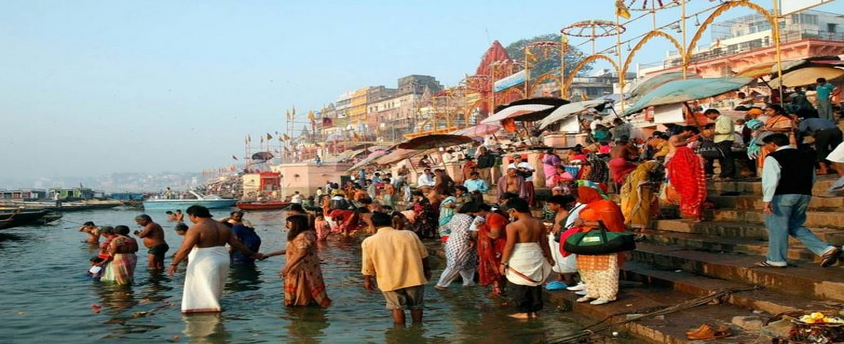
Why in News?
- The 12-day Pushkaralu festival of Telugu-speaking people began on April 22 in Varanasi.
Pushkaralu Festival
- Pushkaram is an Indian festival dedicated to worshiping of 12 sacred rivers.
- The celebration happens annually, once in 12 years along each river.
- Each river is associated with a zodiac sign, and the river for each year’s festival is based on which sign Bruhaspathi (Jupiter) was in at the time.
- It is believed that bathing in the sacred river during Pushkaram cleanses the devotees of their sins.
- This year festival involves worshipping ancestors and the river Ganga and is being organised in Kashi after a gap of 12 years.
Why is it celebrated once in 12 years?
- In India, we have 12 major rivers such as Ganga, Yamuna, Narmada, Saraswathi, Godavari, Krishna, Kaveri, Bhima, Tapati, Tungabhadra, Sindhu, Pranhita for which the Pushkaram festival is celebrated for each river according to the zodiac sign of that river.
- The 12 days after the Jupiter enters that particular zodiac sign will be the Pushkaram/Pushkaralu which is a 12-day festival for that river.
- Hence Pushkaralu comes for every 12 years.
Legend of the Festival
- According to legend, after severe penance, the devotee Pushkara was blessed by Lord Shiva with the ability to live in water and purify holy rivers
- On a request from Bruhaspati (Jupiter), Pushkara decided to enter one of the 12 sacred rivers, including Ganga, Yamuna, Godavari, and Krishna, among others
- The river for each year’s festival is decided in accordance with Brihaspati travel from one zodiac sign to another
Vaikom Satyagraha
31, Mar 2023

Why in News?
- Precisely a century ago, Kerala’s Vaikom town which was then in the princely state of Travancore became the epicentre of a historic non-violent movement against untouchability and caste discrimination.
Background:
- Vaikom Satyagraha that lasted for 604 days (20 months) from March 30, 1924 to November 23, 1925 marked the dawn of temple entry movements across India.
- According to the prevalent caste system in Kerala and the rest of India, low-caste Hindus were not allowed to enter the temples.
- In the Kakinada meet of the Congress Party in 1923, T K Madhavan presented a report citing the discrimination that the depressed castes’ people were facing in Kerala.
- It was after this session that movements against untouchability needed to be promoted.
- In Kerala, a committee was formed comprising people of different castes to fight untouchability.
- The committee chaired by K Kelappan, comprised of T K Madhavan, Velayudha Menon, K Neelakantan Namboothiri and T R Krishnaswami Iyer.
- Other prominent figures included Kurur Neelakanthan Namboodiri and Mannathu Padmanabhan
- In February 1924, they decided to launch a ‘Kerala Paryatanam’ in order to get temple entry and also the right to use public roads for every Hindu irrespective of caste or creed.
About Vaikom:
- Vaikom is situated on the western side of Kottayam district in the Indian state of Kerala.
- It shares its border with Vembanad Lake.
- Its importance in Indian history is due to the Vaikom Satyagraha against untouchability, in which Mahatma Gandhi and Periyar Ramasamy participated.
Significance of the Vaikom Satyagraha:
- It became a first struggle for human rights in India
- It became a laboratory for testing important methods such as
- Instilled rationality among the masses.
Role of Periyar in Vaikom Satyagraha:
- The satyagraha began on March 30,1924 with the active support of the Kerala Pradesh Congress Committee(KPCC).
- The KPCC wrote to Periyar pleading with him to lead the satyagraha.
- As he was then the president of the Tamil Nadu Congress Committee, Periyar handed over temporary charge to Rajaji before reaching Vaikom on April 13, 1924.
- He was part of every consultative meeting, peace committee, campaign party, etc., including the eight-member deputation constituted to meet the Diwan.
- Every major personality who came to Vaikom met with Periyar, this included Swami Shraddhananda of the Arya Samaj,Rajaji met Periyar,Sree Narayana Guru and Gandhi.
Success of Vaikom Satyagraha:
- The satyagraha ended in partial victory in November 1925: three out of four streets were thrown open.
- Final victory came 11 years later with the Travancore Temple Entry Proclamation of 1936.
Bhima-Koregaon Battle Anniversary
02, Jan 2023
Why in News?
- The 205th anniversary of the Bhima-Koregaon battle passed without incident as lakhs of Ambedkarites from across Maharashtra and the country congregated near the Ranstambh (victory pillar) in Perne village in Pune district under heavy security cover.
About the Bhima- Koregaon battle:
- A battle was fought in Bhima Koregaon, a district in Pune with a strong historical Dalit connection, between the Peshwa forces and the British on January 1, 1818.
- The British army, which comprised mainly of Dalit soldiers, fought the upper caste-dominated Peshwa army. The British troops defeated the Peshwa army.
Outcomes of the battle:
- The victory was seen as a win against caste-based discrimination and oppression. Peshwas were notorious for their oppression and persecution of Mahar Dalits. The victory in the battle over Peshwas gave Dalits a moral victory a victory against caste-based discrimination and oppression and sense of identity.
- However, the divide and rule policy of the British created multiple fissures in Indian society which is even visible today in the way of excessive caste and religious discrimination which needs to be checked keeping in mind the tenets of the Constitution.
Why Bhima Koregaon is seen as a Dalit symbol?
- The battle has come to be seen as a symbol of Dalit pride because a large number of soldiers in the Company force were the Mahar Dalits. Since the Peshwas, who were Brahmins, were seen as oppressors of Dalits, the victory of the Mahar soldiers over the Peshwa force is seen as Dalit assertion.
- On 1 January 1927, B.R. Ambedkar visited the memorial obelisk erected on the spot which bears the names of the dead including nearly two dozen Mahar soldiers. The men who fought in the battle of Koregaon were the Mahars, and the Mahars are Untouchables.
Jallikattu
11, Jan 2022
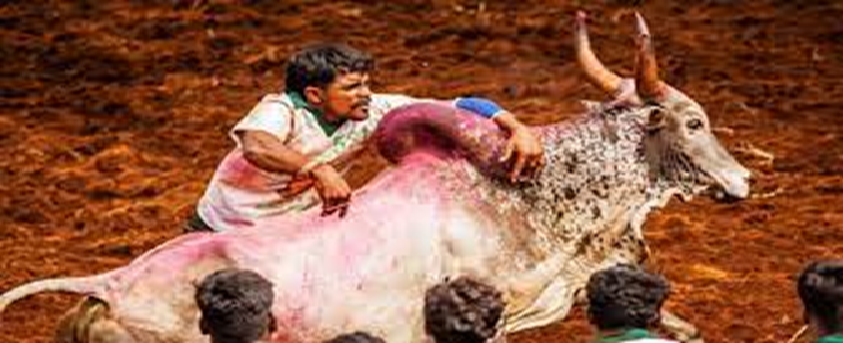
Why in News?
- With a steep rise in the daily cases of COVID-19, the district administration in Vellore, Tiruvannamalai, Ranipet and Tirupattur, have banned the conduct of Jallikattu events, ahead of Pongal festival, as part of Safety Measures.
What is Jallikattu?
- The bull-taming sport is popular in Madurai, Tiruchirappalli, Theni, Pudukkottai and Dindigul districts known as the Jallikattu belt.
- Jallikattu is celebrated in the second week of January, during the Tamil harvest festival, Pongal.
- A tradition over 2,000 years old, Jallikattu is a competitive sport as well as an event to honour bull Owners who rear them for Mating.
- It is a violent sport in which contestants try to tame a bull for a prize; if they fail, the bull Owner Wins the Prize.
Why is Jallikattu Important in Tamil culture?
- Jallikattu is considered a traditional way for the peasant community to preserve their pure-breed native bulls.
- At a time when cattle breeding is often an artificial process, conservationists and peasants argue that Jallikattu is a way to protect these male animals which are otherwise used only for Meat if not for Ploughing.
Why has Jallikattu been the Subject of Legal Battles?
- Jallikattu first came under legal scrutiny in 2007 when the Animal Welfare Board of India and the animal rights group PETA moved petitions in the Supreme Court against Jallikattu as well as bullock cart races.
- The Tamil Nadu government, however, worked its way out of the ban by passing a law in 2009, which was signed by the Governor.
- In 2011, the UPA regime at the Centre added bulls to the list of animals whose training and exhibition is prohibited.
- In May 2014, days before the BJP was elected to power, the Supreme Court banned the bull-taming sport, ruling on a petition that cited the 2011 notification.
So, is it legal or Banned Now?
- In January 2017, massive protests erupted across Tamil Nadu against the ban, with Chennai city witnessing a 15-day-long Jallikattu uprising.
- The same year, the Tamil Nadu government released an ordinance amending the central Act and allowing Jallikattu in the state; this was later ratified by the President.
- The amendment was subsequently approved by the President of India, effectively overturning the Supreme Court ban and allowing the sport to be played without any legal hurdle.
- PETA challenged the state move, arguing it was unconstitutional (Article 29(1)).
- In 2018, the Supreme Court referred the Jallikattu case to a Constitution Bench, where it is Pending Now.
KARTARPUR SAHIB DAMAGE
20, Apr 2020
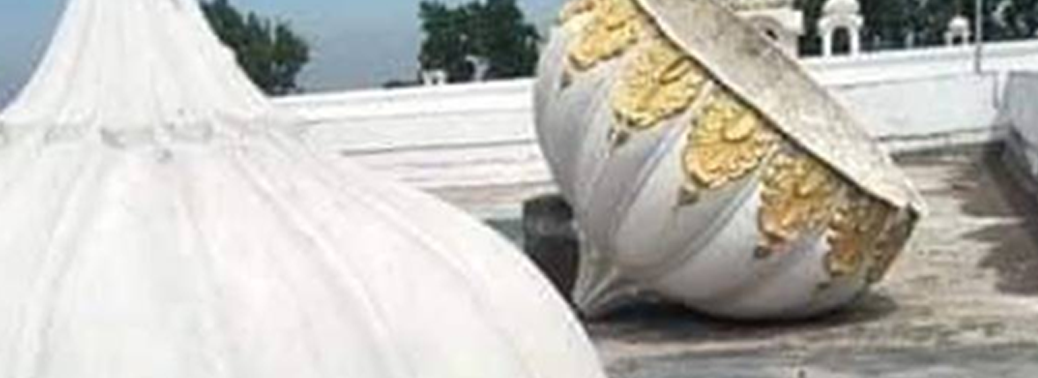
Why in News?
- India has asked Pakistan to repair and reconstruction of parts of Kartarpur Sahib gurudwara that was damaged in a Recent Storm.
About Katarpur Sahib:
- Guru Nanak Dev travelled through many countries spreading the message of universal peace, harmony and love before finally arriving in Kartarpur in 1521.
- Kartarpur became a religious site after he settled there.
- The shrine in Pakistan’s Narowal district, built where founder of the Sikh faith, Guru Nanak Dev, lived the last years of his life, is highly revered by followers of the faith and other worshippers in India and the world.
- The foundation stone of the gurdwara in Kartarpur was laid in 1572 and Maharaja Ranjit Singh covered its dome with gold.
- The present structure was built by Bhupinder Singh, the Maharaja of Patiala in 1925.
About Guru Nanak:
- Guru Nanak Dev Jayanti is observed to celebrate the birth of Guru Nanak Dev (1469-1539), who is first of the 10 Sikh Gurus and the founder of Sikhism.
- He advocated the ‘Nirguna’ (devotion to and worship of formless divine) form of bhakti.
- He rejected sacrifices, ritual baths, image worship, austerities and the scriptures of both Hindus and Muslims.
- He organised his followers into a community. He set up rules for congregational worship (Sangat) involving Collective Recitation.
NATIONAL LIST OF INTANGIBLE CULTURAL HERITAGE (ICH) OF INDIA LAUNCHED
20, Apr 2020
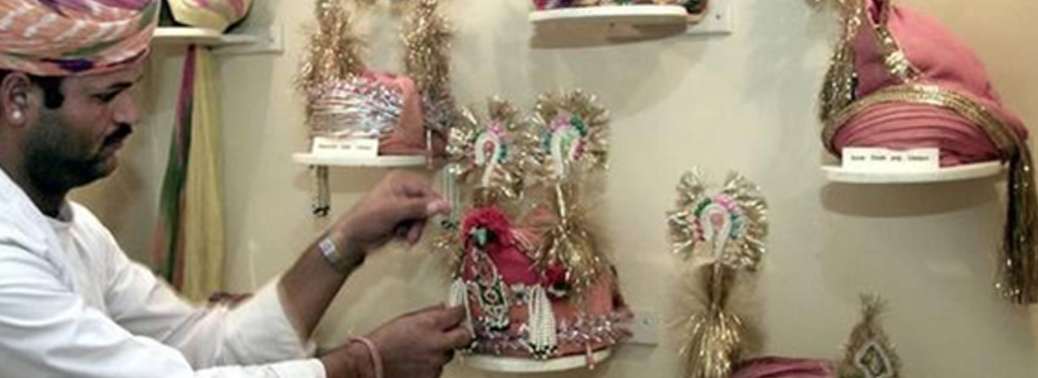
Why in News?
- Union Minister for Culture (I/C) has launched the National List of Intangible Cultural Heritage (ICH) of India in New Delhi.
Highlights:
- India houses a repository of unique Intangible Cultural Heritage (ICH) traditions, 13 of which have also been recognized by UNESCO as Intangible Cultural Heritage of Humanity.
- The National ICH List is an attempt to recognize the diversity of Indian culture embedded in its intangible heritage.
- It aims to raise awareness about the various intangible cultural heritage elements from different states of India at national and international level and ensure their protection. This initiative is also a part of the Vision 2024 of the Ministry of Culture.
- The present items in the list have been collated from the projects sanctioned under the scheme for ‘Safeguarding the Intangible Cultural Heritage and Diverse Cultural Traditions of India’ formulated by the Ministry of Culture in 2013.
- As of now the list has more than 100 elements. It also includes the 13 elements of India that have already been inscribed on the UNESCO Representative List of the Intangible Cultural Heritage of Humanity.
- The list functions as a tentative list for any potential inscriptions on the UNESCO list ofIntangible Cultural Heritage.
Classification:
- Following UNESCO’s 2003 Convention for Safeguarding of Intangible Cultural Heritage, this list has been classified into five broad domains in which intangible cultural heritage is Manifested:
- Oral traditions and expressions, including language as a vehicle of the intangible cultural heritage;
- Performing arts;
- Social practices, rituals and festive events;
- Knowledge and practices concerning nature and the universe;
- Traditional craftsmanship.
- The List Includes:
- Assam:The traditional folk festival of Pachoti, where the birth of a baby, particularly a male infant as the tradition relates to the birth of Krishna is celebrated with relatives and neighbours.
- Delhi:The oral traditions of the transgender community called Kinnar Kanthgeet and compositions of Ameer Khusro.
- Gujarat: Patola silk textiles from Patan with its geometric and figurative patternsalso made it to the list.
- Rajasthan:The practice of tying a turban or safa across Rajasthan was a part of the list.
- Jammu and Kashmir: The Kalam Bhat or Qalambaft gharana of Sufiana music in Budgam district and from Ladakh. The Buddhist chanting across both Leh and Kargil districts were on the list of intangible cultural heritage.
- Manipur:The making of khor, a rice beer, by the Tangkhul community in Manipur as well as other crafts associated with it, like making gourd vessels and wicker baskets, were also on the list.
- Kerala:Martial art form, Kalaripayuttu, and the practice of making designs at the entrance of homes and temples called kolam in Kerala, Andhra Pradesh, Tamil Nadu and Andhra Pradesh were also included in the list.
- Different forms of Shadow Puppet Theatre:
- Chamadyacha Bahulya in Maharashtra,
- Tolu Bommalatta in Andhra Pradesh,
- Togalu Gombeyatta in Karnataka,
- Tolu Bommalattam in Tamil Nadu,
- Tolpava Kuthu in Kerala and Ravanchhaya in Orissa — have also been included.
- Through consultation from experts and other stakeholders like UNESCO, this list could also help strengthen the ICH inventory of India, which functions as a ‘tentative list’ for any potential inscriptions on the UNESCO list of Intangible Cultural Heritage.
NOMINATIONS FOR WORLD HERITAGE LIST FOR THE YEAR 2020
03, Mar 2020
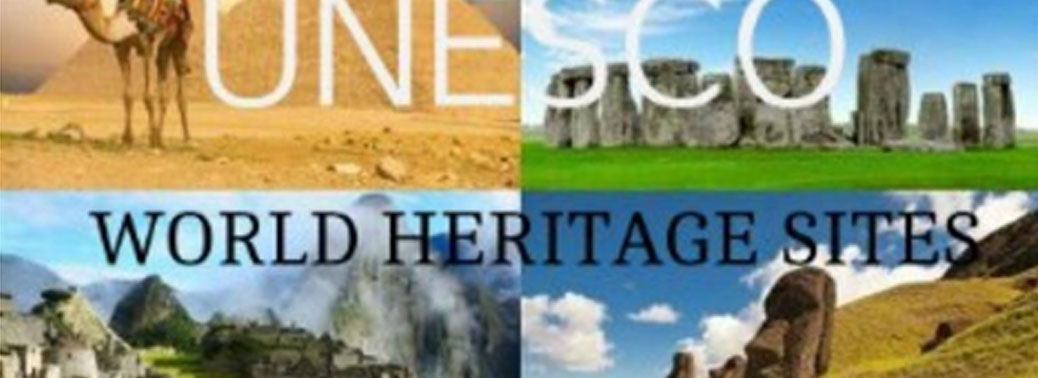
Why in News?
- Nomination dossiers of ‘Dholavira: A Harappan City’ and ‘Monuments and Forts of Deccan Sultanate’ have been submitted for inclusion in the World Heritage List for the year 2020 – Culture Minister.
UNESCO World Heritage List:
- This list comprises the UNESCO World Heritage Sites. A World Heritage Site is a landmark or an area selected by the UNESCO for having cultural, historical, scientific or other form of significance, which is legally protected by international treaties.
- The sites are regarded important for the collective and preservative interests of humanity.
- To be selected, a World Heritage Site must be an already-classified landmark, unique in some respect as a geographically and historically identifiable place having special cultural or physical significance.
- The sites are intended for practical conservation for posterity, which otherwise would be subject to risk from human or animal trespassing, unmonitored/uncontrolled/unrestricted access, or threat from local administrative negligence.
- The list is maintained by the international World Heritage Program administered by the UNESCO World Heritage Committee, composed of 21 “states parties” that are elected by their General Assembly.
- As of July 2019, a total of 1,121 World Heritage Sites exist across 167 countries. The maximum number of sites in one country is 55, both China and Italy having 55 each. India is in fifth position with 38 sites.
- The first place to be declared a World Heritage Site: City of Quito (capital of Ecuador) in 1978.
Tentative Lists:
- States Parties are encouraged to submit Tentative Lists to the UNESCO.
- This list consists of properties which they consider to be cultural and/or natural heritage of outstanding universal value and therefore suitable for inscription on the World Heritage List.
- The Tentative List should be submitted at least one year prior to the submission of any nomination.
- Nominations to the World Heritage List will not be considered unless the nominated property has already been included on the State Party’s Tentative List.
- Both Dholavira and the Deccan Sultanate forts and monuments are included in India’s Tentative List. There are another 40 sites in the Indian list.
- Both were submitted in 2014.
Dholavira: A Harappan City:
- Dholavira is located in the Khadir Island in the Rann of Kutch in Gujarat.
- It belonged to the Mature Harappan Phase.
- It is a fortified quadrangular city set in a harsh and arid land. It was once a thriving metropolis for 1200 years between 3000 BCE and 1800 BCE.
- It had access to the sea.
- The city’s ruins show large-scale use of dressed stone in construction.
- Highly polished stone pillars of square or circular section having a central hole are also seen.
- To create a pillar, such segments were piled to attain the requisite height and a wooden pole was inserted to ensure stability. This method of constructing a column was an ingenious alternative to a monolithic column.
- The city also had an excellent water conservation system that ensured regular water supply to the parched land.
- Many antiquities have also been found during excavations.
Why is it included in the List?
- The excavated site demonstrates the ingenuity of the Harappan people to evolve a highly organised system of town planning with perfected proportions, interrelation of functional areas, street pattern and an efficient water conservation system that supported life for more than 1200 years in a hot and arid climate.
- Its water management system was one of the most efficient in the ancient world.
- The city had a three-tier zonation comprising of distinct upper (citadel, bailey) and middle (having a distinct street-pattern, large scale enclosure and a ceremonial ground) towns enclosed by a lower town (with narrower streets, smaller enclosures and industrial area – this feature distinguishes it from the other metropolises of the Indus Valley Civilisation.
- The importance of Dholavira’s planning was furthered with the excavation of Kampilya in Uttar Pradesh, a city considered of mythical origin in the Gangetic plains. Belonging to the Gangetic Civilization, which is considered the second phase of urbanization of the Indian subcontinent, Kampilya adopted the town planning principles (in terms of scale, hierarchy of space and road network) established in Dholavira.
- The area is protected and managed by the Archaeological Survey of India (ASI).
- Globally, Dholavira can be compared to the cities of the Ancient River Valley Civilization, the urban metropolises of the Egyptian, Chinese and Mesopotamian civilisations.
- In the region, Dholavira can be compared to the other major cities of Harappan culture like Mohenjodaro, Harappa, Kalibangan, Rakhigarhi, Banavali and Lothal. The excavated remains of the complete water system distinguish this site from others.
Monuments and Forts of the Deccan Sultanate:
- The ‘Monuments of the Deccan Sultanate’ is a serial property comprising of four components.
- They constitute the most representative, most authentic and best-conserved examples of Deccani Sultanate monuments in India.
- The series demonstrates the exemplary convergence of national and international styles of Islamic architecture and their intersections with the prevalent Hindu architecture of the period in southern India, in present-day Karnataka and Andhra Pradesh.
- The contributions of Deccan Sultanate to the arts and architecture of India is impressive with iconic Indo-Islamic monuments constructed in Gulbarga, Bidar, Bijapur and Hyderabad.
- These sites emerged as important medieval fortifications and walled cities of the Deccan Sultanates with a vigorous new architectural style of the sultanate that emerged from encounters with the Deccan Hindu heartland of the period.
- Individually, each of the components of the Deccan Sultanate cover important aspects of Sultanate history with Gulbarga evolving as the first capital of the Bahmani Kingdoms in mid-14thcentury CE including its impressive fortifications, Jami Masjid and royal tombs
- Bidar emerged as the next Bahmani capital in the mid-15thCentury CE.
- Further evolution of the Deccani Sultanate style was done by the Adil Shahi dynasty in the monuments at Bijapur such as the Gol Gumbaz that stands as the 2nd largest dome in world history.
- The final diversification and manifestation of the style is seen in the Qutub Shahi monuments of Golconda fort, tombs and the Charminar at Hyderabad. The iconic Charminar is a ceremonial gateway built to celebrate the foundation of Hyderabad in 1591 A.D.
- Subtly blending influences from Iran, West Asia, southern India, and sometimes Europe, as well as southern and northern India, the arts produced under these Deccan sultanates are markedly different from those of the rest of India and especially from those created under the Mughal patronage.
- The monuments and citadels provide a unique testimony to the social, economic, cultural, political and technological landscape of the period as well as unique expressions of the religious and artistic flowering of the Islamic Sultanate in Southern India.
- The monuments were also accompanied by the development of syncretic forms of art, architecture, language, literature, music, cuisine and costume.
PROJECT DIGITAL POOMPUHAR
04, Feb 2020
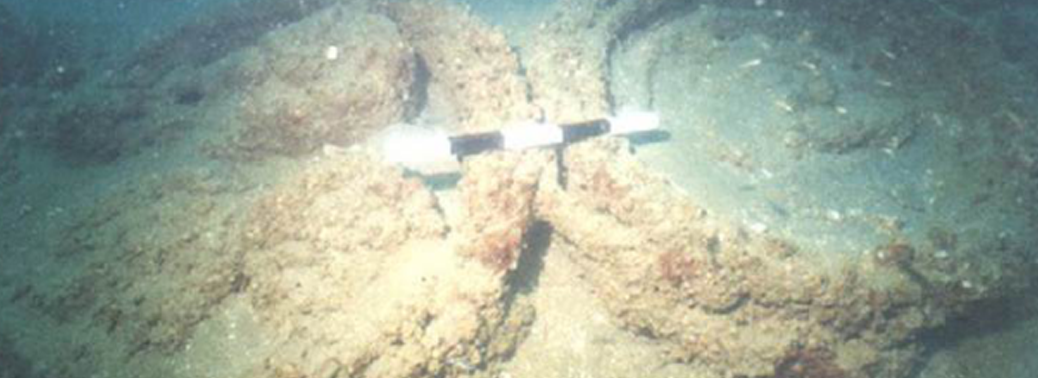
Why in News?
- The Department of Science and Technology (DST)has launched ‘Project Digital Poompuhar’ to recreate the Chola Dynasty port city (Poompuhar) in Tamil Nadu.
About Poompuhar:
- The Poompuharis mentioned in works of Sangam Tamil literature which refers to the city located 30 km from the existing Poompuhar town in southern Tamil Nadu.
- The port city flourished in inter-continental trade but shifted with time. Finally, it was re-established at the present location at the mouth of the river Cauvery around 3,000 years ago.
- The shifts took place due to the continuous “kadalkol” or rising sea levelsand the submergence of the deltas.

What does the Researches on Poompuhar says?
- The Indian Remote Sensing Satellites showed that the city was established initially in the Cauvery Delta about 30km away from the present Poompuhar town around 15,000 years ago.
- It had discovered a harbor like structure as well as sea walls and probably a bridge in the region.
- The study also provided insights about the life history and the social, cultural as well as technological evolution of Poompuhar. It also revealed the age of Poompuhar from 3000 years to 15,000 to 20,000 years.
- Despite several studies on Tamil literature, archaeology, underwater exploration and geosciences, the exact location of initial establishment of Poompuhar, its age, later shifts and the reasons and periods of its extinction, remained unresolved.
About Cholas:
- The Cholas controlled the central and Northern Parts of Tamil Nadu.
- Their core area of the rule was the Kaveri delta, later known as Cholamandalam. Their capital was Uraiyur (near Tiruchirapalli town) and Puhar or Kaviripattinam was an alternative royal residence and chief port town.
- Tiger was their emblem. The Cholas also maintained an efficient navy.
- King Karikala was a famous king of the Sangam Cholas.
- Many Sangam poems mention the Battle of Venni where he defeated the confederacy of Cheras, Pandyas and eleven minor chieftains.
- Trade and commerce flourished during his reign.
- He founded the port city of Puhar (identical with Kaviripattinam) and constructed 160 km of an embankment along the Kaveri River.
About Project Digital Poompuhar:
- The project involves Underwater Surveys and photographyby remotely operated vehicles and remote sensing-based geodynamic studies to bring out comprehensive information on the time series evolution and extinction.
- It also involves the visualisation of geodynamic processes of the last 20,000 yearslike land subsidence, sea-level rise, Cauvery’s migration, floods, tsunami, cyclones and Erosion.
- The study is also expected to provide Scientific Information not only on the life history of Poompuhar and the socio-cultural evolution but also the science and technological evolution and the disaster history of this region.
Is there Any Other Initiative to Revamp the Heritage Sites?
- India Digital Heritageis an initiative by the Department of Science and Technology in the areas of technology and humanities for digital documentation and interpretation of our tangible and intangible heritage.
- The project highlights art, architecture and cultural legacy of the world heritage site Hampi in Karnataka, the medieval capital of the Vijayanagara dynasty.
THE PAIN OF HOLOCAUST: 75 YEARS SINCE AUSCHWITZ LIBERATION
23, Jan 2020
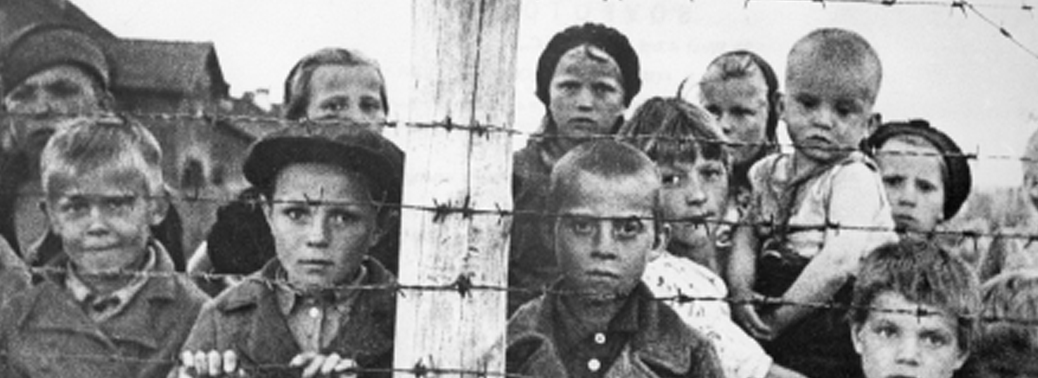
Context:
- Jerusalem is hosting the largest political gathering in its history, leaders from around the world gather to attend the Fifth World Holocaust Forum and speak out against the rise of anti-Semitism and commemorate the Holocaust.
Anti-Semitism and Aryanization:
- The twin goals of racial purity and spatial expansion were the core of Hitler’s worldview
- The Nazis started their persecution for political opponents such as Communists or Social Democrats.
- The first official concentration camp opened at Dachau (near Munich) in March 1933.
- In 1933, Jews in Germany numbered the total German population.
- During the next six years, Nazis undertook an “Aryanization” of Germany, dismissing non-Aryans from civil service, liquidating Jewish-owned businesses and stripping Jewish lawyers and doctors of their clients.
- Under the Nuremberg Laws of 1935, anyone with three or four Jewish grandparents was considered a Jew, while those with two Jewish grandparents were designated Mischlinge (half-breeds).
- Jews became routine targets for stigmatization and persecution.
Holocaust:
- Holocaust, or Shoah is the systematic state-sponsored killing of six million Jewish men, women, and children and millions of others by Nazi Germany and its collaborators during World War II.
75 Years Since Auschwitz Liberation:
- After the start of World War II, Adolf Hitler (1889-1945), the chancellor of Germany, implemented a policy known as the “Final Solution to the Jewish Question.”
- ‘Final Solution’ – involved the elimination of Jews, Artists, Educators, Romas, Communists, Homosexuals, the mentally and physically handicapped and others deemed unfit for survival in Nazi Germany.
- The death camps were set up for the purpose of killing Jews and other “undesirables,” in what became known as the Holocaust.
- Auschwitz, located in the southern Poland, was the largest of the Nazi concentration and death camps. It was opened in 1940 to serve as a detention centre for political prisoners.
- Later, it evolved into a network of camps where the perceived enemies of the Nazi state were exterminated, often in gas chambers, or used as slave labour, or were subjected to medical experiments.
- During World War II (1939-45), more than 1 million people, lost their lives at Auschwitz.
- In 1945, the defeat of Nazi Germany by the Allied forces became certain and as the Soviet army entered, the Nazis abandoned Auschwitz.
- The Soviet Army discovered mounds of corpses, hundreds of thousands of pieces of clothing and pairs of shoes and seven tons of human hair that had been shaved from detainees before their liquidation.
Aftermath & Lasting Impact of the Holocaust:
- Survivors of the camps found it nearly impossible to return home, as in many cases they had lost their families and been denounced by their non-Jewish neighbours.
- As a result, the late 1940s saw an unprecedented number of refugees, POWs and other displaced populations moving across Europe.
- To punish the perpetrators of the Holocaust, the Allies held the Nuremberg Trials of 1945-46, which brought Nazi atrocities to horrifying light.
- Increasing pressure on the Allied powers to create a homeland for Jewish survivors of the Holocaust lead to a mandate for the creation of Israel in 1948.
AGREEMENT ON BRU REFUGEES FOR RE-SETTLEMENT IN TRIPURA
20, Jan 2020
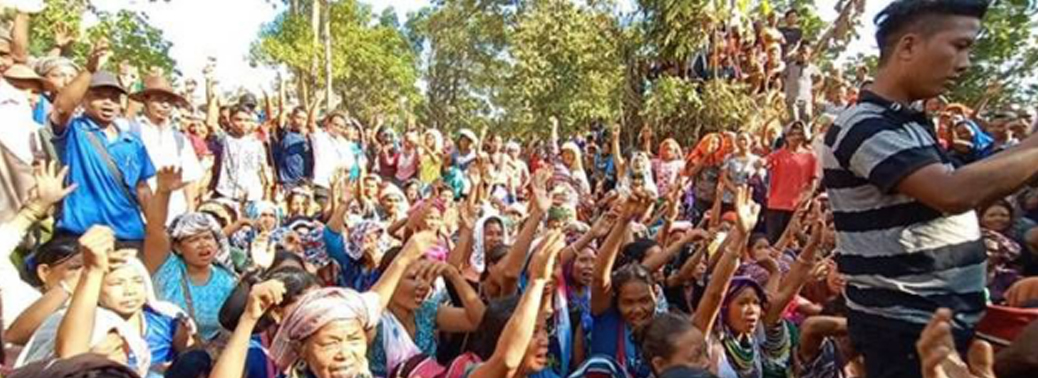
Why in News?
- A quadripartite agreement has been signed recently which allows some 35,000 Bru tribal people, who were displaced from Mizoram and are living in Tripura as refugees since 1997, to settle permanently in Tripura.
- The Centre, State governments of Tripura and Mizoram, and representatives of Bru organisations signed the agreement in the presence of Union Home Minister.
Background Info:
- The Brus – spread across Tripura, Mizoram and parts of southern Assam–are the most populous tribe in Tripura.
- Also known as Reangs in the state, they are ethnically different from the Mizos, with their own distinct language and dialect.
- In 1997, following ethnic tension, around 5,000 families comprising around 30,000 Bru-Reang tribals were forced to flee Mizoram and seek shelter in Tripura. Since then these people were housed in temporary camps in Tripura.
- Since 2010, Government of India has been making sustained efforts to permanently rehabilitate these refugees. The Union government has been assisting the two State governments for taking the care of the refugees and helping them to return to Mizoram in batches.
- In 2018, an agreement was signed between the Union government, the two State governments and representatives of Bru-Reang refugees, as a result of which the aid given to these families was increased substantially.
- There had been a sustained demand from most Bru – Reang families that they may be allowed to settle down in Tripura permanently, considering their apprehensions about their security in Mizoram.
Settlement of Bru Refugees in Tripura:
- Under the new agreement which was signed recently, around 34,000 Bru refugees will be settled permanently in Tripura and would be given aid from the Centre to help with their rehabilitation and all round development, through a package of around Rs 600 crores.
- These refugees will get all the rights that normal residents of the States get and they would now be able to enjoy the benefits of social welfare schemes of Centre and State governments.
- Under the new arrangement, each of the displaced families would be given residential plots, in addition to the earlier aid agreed under earlier agreement.
Criticism of the above move:
- The “solution” has evoked mixed reactions with rights activists fearing it could set a bad precedent, encouraging ethno-centric states to eject minorities from their states.
- The Brus who returned to Mizoram might also demand a package equivalent to the one those who stayed in Tripura.
- This move might also result in conflict between indigenous tribes of Tripura and resettled Bru tribes, since the above move could be seen by local people as a threat to their employment and livelihood.
HARYANA’S JOHADS SET FOR REVAMP
27, Nov 2019

Why in News?
- Haryana’s Johads are all set for a revamp. The state government has come out with a plan of rehabilitating over 16,400 ponds in rural areas across the state in order to analyze pond water to ascertain its suitability for irrigation and other uses.
About:
- Johads are community-owned rainwater storage wetland mainly used for harnessing water resources.
- It is used in the state of Haryana, Rajasthan, Punjab, and western Uttar Pradesh.
- It collects and stores water throughout the year, to be used for the purpose of recharging the groundwater in the nearby water wells, washing, bathing and drinking by humans and cattle.
- Some johads also have bricked or stones masonry and cemented ghat.
- Other names of Johads (Haryanvi language and Rajasthani language) sarovar, taal and talab in Hindi language, and water pond or lake in English. Johads are called as khadin in Jaisalmer district.
Traditional Water Conservation:
- History tells us that both floods and droughts were regular occurrence in ancient India.
- Perhaps this is why every region in the country has its own traditional water harvesting techniques that reflect the geographical peculiarities and cultural uniqueness of the regions.
- The basic concept underlying all these techniques is that rain should be harvested whenever and wherever it falls.
- Archaeological evidence shows that the practice of water conservation is deep rooted in the science of ancient India.
- Excavations show that the cities of the Indus Valley Civilization had excellent systems of water harvesting and drainage.
- The settlement of Dholavira, laid out on a slope between two storm water channels, is a great example of water engineering.
- Chanakya’s Arthashashtra mentions irrigation using water harvesting systems.
- Sringaverapura, near Allahabad, had a sophisticated water harvesting system that used the natural slope of the land to store the floodwaters of the river Ganga.
- Chola King Karikala built the Grand Anicut or Kallanai across the river Cauvery to divert water for irrigation (it is still functional) while King Bhoja of Bhopal built the largest artificial lake in India.Drawing upon centuries of experience, Indians continued to build structures to catch, hold and store monsoon rainwater for the dry seasons to come.
- These traditional techniques, though less popular today, are still in use and Efficient.
Other Traditional Water Conservation Techniques:
- Zing – It is found in Ladakh, are small tanks that collect melting glacier water. A network of guiding channels brings water from the glacier to the tank.
- Kuhls – They are surface water channels found in the mountainous regions of Himachal Pradesh. The channels carry glacial waters from rivers and streams into the fields.
- Jack wells – The Shompen tribe of the Great Nicobar Islands uses this system, in which bamboos are placed under trees to collect runoff water from leaves and carries it to jack wells which pits encircled by bunds are made from logs of hard wood.
- Pat system – It is developed in Madhya Pradesh, in which the water is diverted from hill streams into irrigation channels by diversion bunds. They are made across the stream by piling up stones and teak leaves and mud.
- Eri – It is tank system, widely used in Tamil Nadu which acts as flood-control systems, prevent soil erosion and wastage of runoff during periods of heavy rainfall, and also recharge the groundwater.
- Zabo or Ruza System– It is practiced in Nagaland. Rainwater that falls on forested hilltops is collected by channels that deposit the run-off water in pond-like structures created on the terraced hillsides.
- Phad – It is a community-managed irrigation system in the tapi river basin in Maharashtra. It starts with check dam built across a river and canals to carry water to agricultural blocks with outlets to ensure excess water is removed from the canals.
- Panam keni – The Kuruma tribe (a native tribe of Wayanad) uses wooden cylinders as a special type of well, which are made by soaking the stems of toddy palms and immersed in groundwater springs.
- Ahar Pynes – They are traditional floodwater harvesting systems indigenous to South Bihar. Ahars are reservoirs with embankments on three sides and Pynes are artificial rivulets led off from rivers to collect water in the Ahars for irrigation in the dry months.
- Jhalara – Jhalaras are typically rectangular-shaped step wells that have tiered steps on three or four sides in the city of Jodhpur.
- Bawari – Bawaris are unique step wells that were once a part of the ancient networks of water storage in the cities of Rajasthan.
- Taanka – It is a cylindrical paved underground pit into which rainwater from rooftops, courtyards or artificially prepared catchments flows. It is indigenous to the Thar Desert region of Rajasthan.
- Khadin – Also called dhora, is a long earthen embankment that is built across the hill slopes of gravelly uplands. It is indigenous to Jaisalmer region and similar to the irrigation methods of Ur region (Present Iraq).
- Kund – It is a saucer-shaped catchment area that gently slopes towards the central circular underground well. It is found in the sandier tracts of western Rajasthan and Gujarat.
Why it is Needed?
- Water is a cyclic resource which can be used again and again after cleaning.
- The best way to conserve water is its judicious use.
- A large quantity of water is used for irrigation and there is an urgent need for proper water management in irrigation sector.
- In arid areas, wherever water has been brought for irrigation, saline and alkaline tracts have emerged, rendering the soil infertile.
- Wasteful use of water should be checked. Sprinkler irrigation and drip irrigation can play a crucial role in conserving scarce water resources in dry areas.
- Drip irrigation and sprinkles can save anywhere between 30 to 60 per cent of water.
- Only 0.5 per cent—nearly half of this in Maharashtra—is under drip irrigation and 0. 7 per cent under sprinklers.
- There is large-scale pollution of water as a result of industrialization and urbanisation. This trend has got to be checked.
- Although one-eighth of India is declared as food prone, there are several thousand villages in India which do not have potable Drinking Water.
- The basins should be treated as one unit for planning water utilization.
- Dry farming should be practiced in dry areas.
- The experimentation under the National Watershed Development Programme for Rainfed Agriculture is being carried on since 1986-87.
KUNG FU NUNS OF THE DRUKPA ORDER
06, Nov 2019
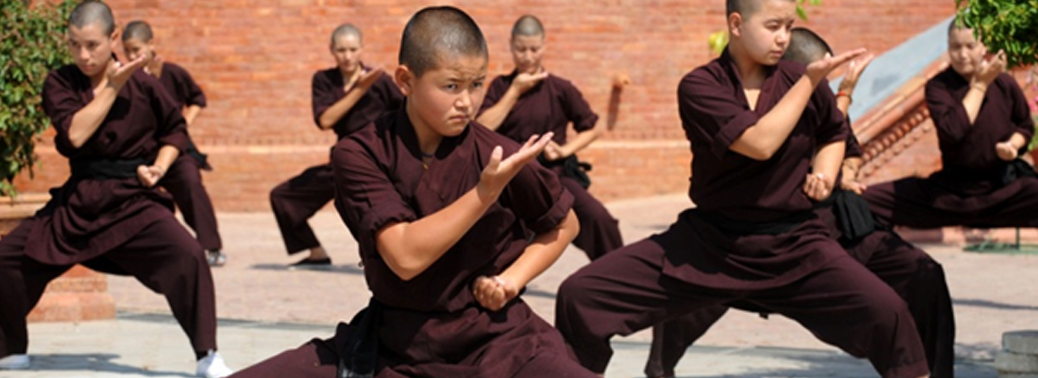
Why in News?
- Union Minister of State for Tourism and Culture met the Kung Fu Nuns of the Drukpa Order.
- The Kung Fu Nuns recently received the Asia Society’s prestigious Game Changer Award in New York for their path-breaking work to empower women and dismantle gender stereotypes in the Himalayas.
The Kung Fu Nuns:
- The Kung Fu Nuns are a strong community of 700 nuns and growing, with a thousand-year-old Drukpa legacy.
- They represent a new generation of Buddhists who use their teachings to take real action and effect meaningful change in the world by promoting gender equality and environmentalism.
- The Nuns use Jigme as their first name and the meaning of Jigme is ‘fearless’.
- With this recognition, the Kung Fu Nuns join the likes of iconic Indian leaders Indra Nooyi, Mukesh Ambani, and Dev Patel, who have also been honored by the Asia Society.
Drukpa Order:
- The Kung Fu Nuns are the fearless daughters of India who represent a new generation of Buddhists using spirituality to inspire real-life action & impact.
- Harnessing the ancient martial art to build strength, promote equality, and improve communities, they are inspiring young girls to break stereotypes and be their own heroes.
- They belong to the Drukpa Lineage, a thousand-year-old Buddhist tradition that began in the Himalayas.
- The Gyalwang Drukpa, the spiritual leader and founder of the Drukpa order, encouraged his nuns to train in Kung Fu to build confidence as leaders.
- In doing so, he flouted centuries of Buddhist tradition that barred nuns from physical exercise.
- They are the only Buddhist nuns in the world to practice Kung Fu. The nuns use their martial arts expertise to challenge gender roles in India’s conservative culture.
Asia Society Game Changer Awards:
- Founded in 1956, the Asia Society is a nonpartisan, non-profit educational institution.
- It holds offices in Hong Kong, Houston, Los Angeles, Manila, Melbourne, Mumbai, NYC, San Francisco, Seoul, Shanghai, Tokyo, Washington DC and Zurich.
- The society is dedicated to promoting mutual understanding and strengthening partnerships among people, leaders and institutions of Asia and the United States in a global context.
- Each year, the Asia Society honor individuals, organizations, or movements that have inspired, enlightened, and shown true leadership in areas that reflect Asia Society’s core pillars of policy and business, arts and culture, and education.
DIGITAL BHARAT DIGITAL SANSKRITI
22, Oct 2019
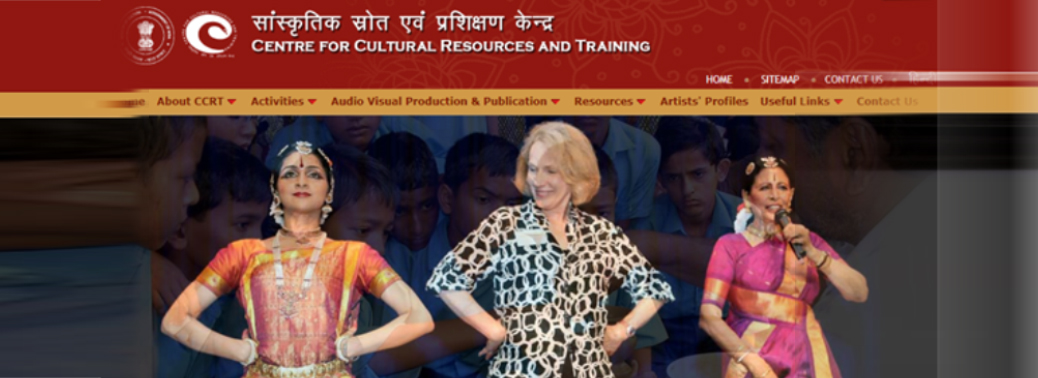
Why in News?
- The Union Minister of State for Culture & Tourism inaugurated the CCRT e-portal and YouTube Channel at the event “Digital Bharat Digital Sanskriti” In New Delhi.
Highlights:
- The program is organised by the Rashtriya Centre for Cultural Resources and Training, under the Ministry of Culture.
- With an aim to take India to a newer digital pinnacle and to promote Indian culture, the CCRT e-portal and YouTube Channel are launched, with great support from The Marketing Heaven.
- In order to explore and understand the unknown aspects of India’s lesser-known places and their rural and semi-urban culture, CCRT has started publishing books from the series “Untold Tales of India’s Cities”.
Centre for Cultural Resources and Training (CCRT):
- It is an autonomous organisation under the Ministry of Culture of the Government of India.It works in the field of linking education with culture.
- It was established in 1979 pioneered by Smt. Kamaladevi Chattopadhyay and Dr. Kapila Vatsyayan.At the philosophical core of the CCRT lies a commitment to holistic education, encompassing the cognitive, emotional and spiritual development of children.
- To this end the CCRT conducts education grounded in cultural knowledge and understanding as conducive to clarity, creativity, independence of thought, tolerance and compassion.CCRT’s main thrust is to make a variety of training programmes for in-service teachers, teacher educators, educational administrators and students throughout the country.It also organizes special training programmes for physically and mentally challenged children.The training programmes provide an understanding and appreciation of the philosophy, aesthetics and beauty inherent in Indian art and culture and focus on formulating methodologies for incorporating a cultural component in curriculum teaching.
- It organises theoretical and theme-based academic programmes on Indian art and culture for teachers and students.
AUDIO GUIDE FACILITY APP “AUDIO ODIGOS”
04, Oct 2019

Why in News?
- On the second day of nationwide “Paryatan Parv 2019” Ministry of Tourism launched the Audio Guide facility Audio Odigos for 12 sites of India(including Iconic Sites).
Audio Guide- Audio Odigos:
- It is an app for the benefit of the tourists. Audio guide odigo offers Government of India verified content, with visuals & voice over support.
- With Audio Odigos, tourists will now enjoy a more enriching experience and take back historical insights of the Indian culture and heritage.
- The Audio Odigos app contains an inbuilt map of the site for a smooth navigation during the tour.Listeners will be offered various versions of history like Synopsis, Detailed History and Podcasts.The audio can be chosen in their preferred language & version of the history. Audio Odigos is now available for download on all Android and iOS supported mobile phones.Audio Guide facility Audio Odigos can be used in 12 sites that includes: Amer Fort, Rajasthan, Chandni Chowk, Red Fort, Purana Quila, Humayun’s tomb, Delhi, Fatehpur Sikri, Taj Mahal, Uttar Pradesh, Somnath and Dholavira, Gujarat, Khajuraho, Madhya pradesh, Mahabalipuram, Tamil Nadu and Mahabodhi Temple, Bihar.
‘Adopt a Heritage, Apni Dharohar Apni Pehchan’ Scheme:
- It is a scheme of Ministry of Tourism for development of Tourism Amenities. The project aims to develop synergy amongst all stakeholders and involves active participation of local communities / players to promote ‘responsible tourism’.
- It is a collaborative effort between the Ministry of Tourism, Ministry of Culture and Archaeological Survey of India (ASI) and State Governments / UT Administrations. It aims at involving public sector companies, private sector companies and corporate citizens/individuals to take up the responsibility for making our heritage and tourism more sustainable through development, operation and maintenance of world-class tourist infrastructure and amenities at ASI/ State heritage sites and other important tourist sites in India.
PARYATAN PARV 2019
03, Oct 2019
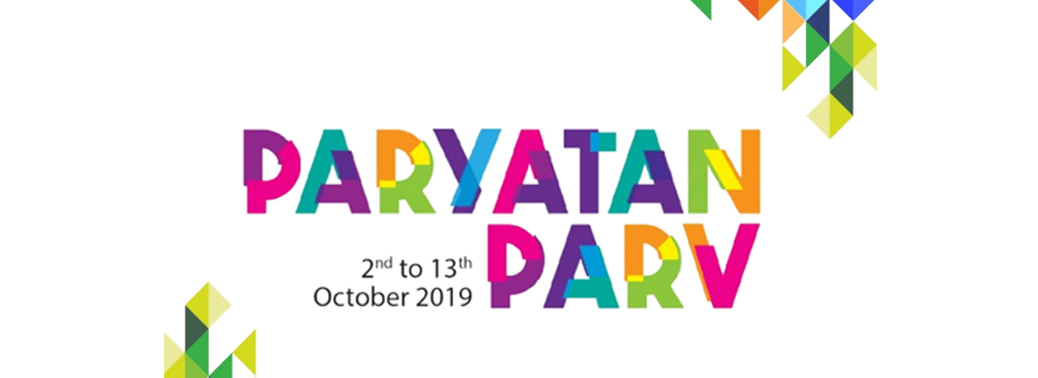
Why in News?
- Ministry of Tourism organised Paryatan Parv 2019, which will be held from 2nd to 13th October, 2019.
About Paryatan Parv:
- The idea of Paryatan Parv is to propagate the message of ‘DekhoApna Desh’, with the objective to encourage Indians to visit various tourist destinations of the country and also to spread the message of ‘Tourism for All’.Paryatan Parv 2019 is dedicated to 150th Birth Anniversary of Mahatma Gandhi. Paryatan Parv is being organized with the objective of drawing focus on the benefits of tourism, showcasing the cultural diversity of the country and reinforcing the principle of “Tourism for All”.
- The three components of Paryatan Parv, are:
- Dekho Apna Desh: To encourage Indians to visit their own country. In the run up to the parv, several activities have been organised across the Country like Photography contest covering tourism attractions and experiences, promotion on Social Media, Tourism related Quiz, Essay, Debate and Painting Competitions for Students. General public engagement for the event will be promoted through the MyGov platform.
- Tourism for All: Tourism Events at sites across all States in the country are being organised. The activities at these sites will include illumination in and around the Sites, Cultural Programmes of Dance, Music, Theatre, Story Telling, Sensitisation Programmes for Stakeholders around the Sites, Tourism Exhibitions, Showcasing Culture, Cuisine and Handicrafts / Handlooms, Guided Heritage Walks, etc.
- Tourism & Governance: Interactive Sessions & Workshops with Stakeholders on varied themes have been organised across the Country as a part of the Paryatan parv activities.
THE MUNICH AGREEMENT AND WORLD WAR II
02, Sep 2019
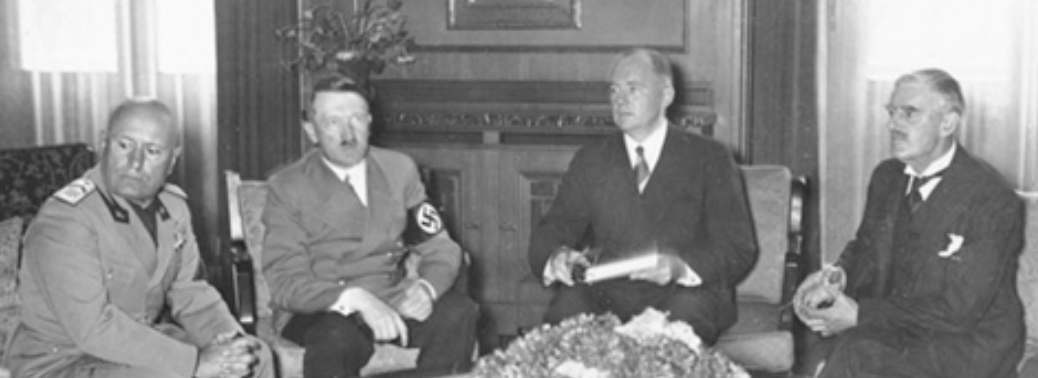
Why in News?
- On -September 1, 1939- 80 years ago— German troops marched into Poland, triggering the beginning of World War II, the deadliest military conflict in the history of mankind, involving an estimated 100 million people from 30 countries.
- Great Britain and France, which had assured help to Poland, declared war on Germany and its allies two days later, on September 3. The beginning of the War exposed to the world the folly of the Munich Agreement that was signed less than a year previously — a deal that has been seen as a disastrous act of appeasement of Adolf Hitler’s Nazi regime, and historical evidence that expansionist totalitarianism cannot be dealt with through placation.
The Sudeten Crisis:
- Hitler had threatened to bring war to Europe unless the German-majority areas in the north, south, and west of Czechoslovakia were surrendered to Germany.
- The German-speaking people living in these areas, referred to in German as Sudetenland, had found themselves part of the new country that was created after the German-dominated Austro-Hungarian Empire collapsed at the end of World War I in 1918.
- The annexation of Sudetenland, home to over three million Sudeten Germans, was part of Hitler’s plan to create a “Greater Germany”. Following the Munich Agreement, German troops occupied these areas between October 1 and October 10, 1938.
The Munich Agreement:
- The Agreement was signed among Germany, France, Italy, and Great Britain on September 29-30, 1938. Hitler’s appeasement in an attempt to keep the peace in Europe was strongly supported by Great Britain’s Prime Minister at the time, Neville Chamberlain.
- After coming back from Munich, Chamberlain waved the piece of paper signed by Hitler and called it a declaration of “peace with honour”. In return for European peace, the Sudetenland region was permitted to be annexed by the Germans.
- Czechoslovakia, the country whose region was about to be annexed, was not officially party to the Agreement. It was forced to agree to the deal under pressure from Great Britain and France, which had a military alliance with the country.
- The Czchoslovak leader Jan Masaryk had famously declared at the time, “We are not ready to accept peace at all costs!” And Prime Minister Jan Syrový, who was forced to accept the Munich Agreement, lamented: “We have been abandoned.”
What Changed?
- The Agreement, signed after Hitler met Chamberlain and French Prime Minister Édouard Daladier along with Italy’s Prime Minister Benito Mussolini in Munich, allowed for the cessation to Germany of Sudetenland. The German occupation was to be done in four stages from October 1-10, 1938.
- The cessation in some places was subject to a plebiscite. The Czechoslovak government was supposed to release from their military and police forces within four weeks of the signing of the Agreement, any Sudeten Germans who wished to be released, and all Sudeten German prisoners. Six months after the Munich Agreement was signed, Hitler went back on his commitments and invaded the whole of Czechoslovakia. War was on its way.
AADI MAHOTSAV AT LEH-LADAKH
18, Aug 2019
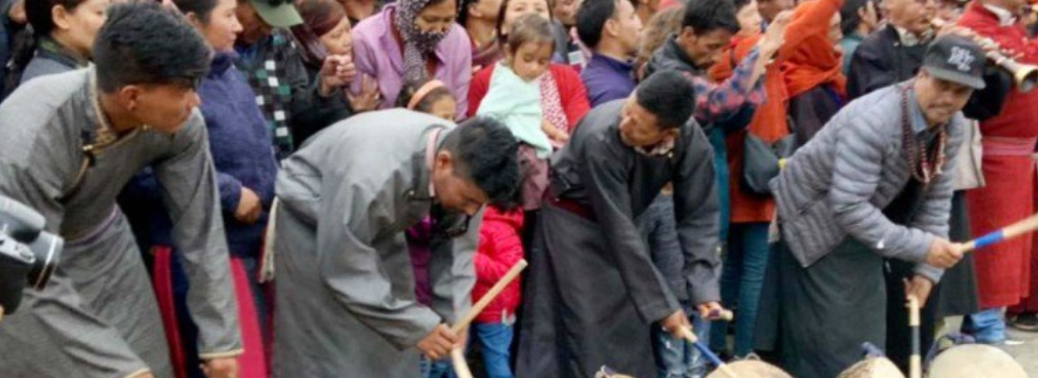
Why in news?
- Aadi Mahotsav (National Tribal Festival) was celebrated on 17th August, 2019 in Leh-Ladakh.
Highlights:
- Aadi Mahotsav is a joint initiative of Ministry of Tribal Affairs, Government of India & Tribal Cooperative Marketing Development Federation of India (TRIFED).
- The theme of the festival is: “A celebration of the spirit of Tribal Craft, Culture and Commerce”.
- The event will see around 160 Tribal artisans from more than 20 states across the country, actively participating and showcasing their masterpieces.
- The product range will comprise of Tribal Textiles from Rajasthan, Maharashtra, Odisha, West Bengal; Tribal Jewellery from Himachal Pradesh, Madhya Pradesh and North East; Tribal Paintings like Gond art from Madhya Pradesh, Warli art from Maharashtra; Metal craft from Chhattisgarh; Black pottery from Manipur, and Naturals and Organic products from Uttarakhand, Madhya Pradesh and Karnataka.
Mahotsav will also cover to identify:
- Food and Forest Produces, which can be processed, value added and marketed under the Van Dhan Scheme of the Ministry of Tribal Affairs.
- Artisans and master craftsmen and women of Ladakh for empanelling them as suppliers of TRIBES India.
Showcasing Digital Skills of the Tribes:
- The Mahotsav apart from exotic handicrafts will also show case the electronic and digital skills of the tribals as a special attraction.
- In line with the national aspiration to go cashless, for the first time the tribal artisans will be accepting payment through major credit/debit cards for which Point of Sale (POS) machines are provided.
- The Mahotsav will display the rich digital commerce and e-commerce being promoted by Tribes India.
- TRIBES India proudly informs the signing of MOUs with Amazon, Snapdeal, Flipkart, PayTM and GEM, a Government of India Portal for e-commerce of the tribal products.
- TRIBES India has also has its own e-com portal tribesindia.com.
Ladakhi folk dances:
- The troupes will perform
- Jabro Dance: a nomadic dance and song of people inhabiting eastern Ladakh.
- Spawo dance: a heroic song and dance associated with a legendary hero of Himalayan region called K’sar.
MONUMENTS OF VALOUR & VICTORY HOMAGE TO KARGIL WARRIORS
27, Jul 2019
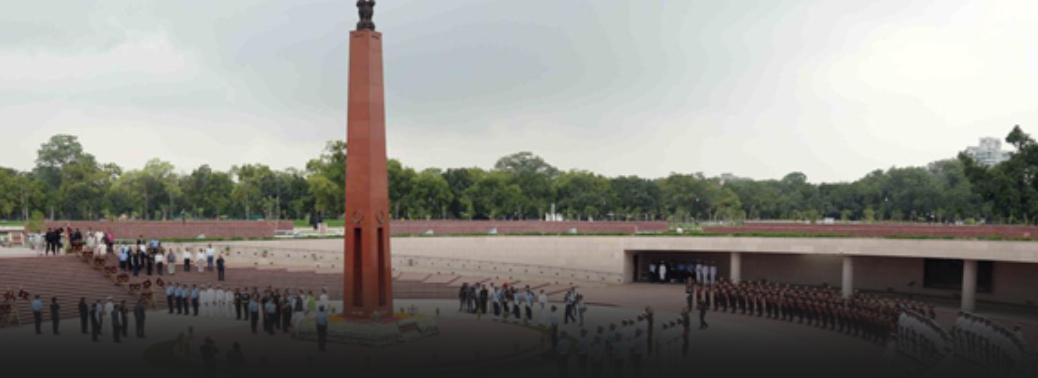
Why in news?
- The Union Culture Minister inaugurated an exhibition of ‘Monuments of Valour & Victory Homage to Kargil Warriors’ on the 20th anniversary of Kargil Vijay Divas.
- The exhibition was organized by National Monuments Authority of Ministry of Culture.
National Monuments Authority (NMA):
- The NMA has been established under the Ancient Monuments and Archaeological Sites and Remains AMASR (Amendment and Validation) Act, 2010.
- It is chiefly engaged in the protection and preservation of monuments and sites through management of the prohibited and regulated area around the centrally protected monuments.
- Another function is to consider grant of permissions to applicants for construction related activity in the prohibited and regulated area.
The NMA is particularly relevant with increasing urbanisation and development. - The NMA is also involved in grading and classifying the monuments.
TITHANKAR CIRCUIT
25, Jul 2019
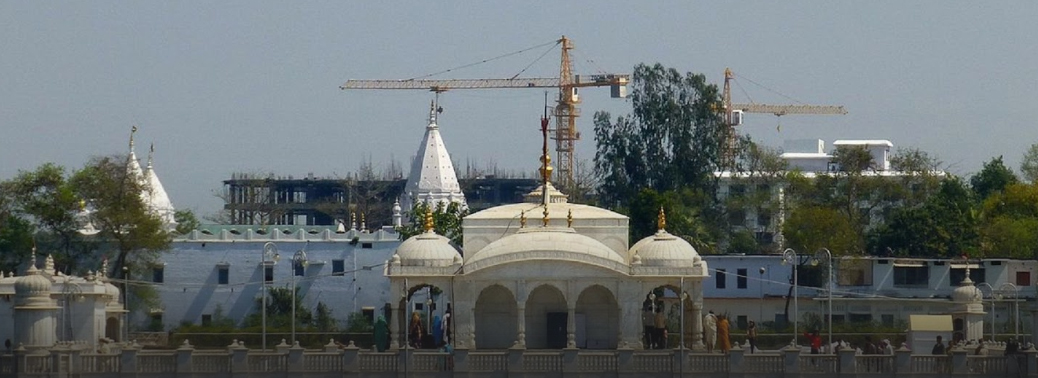
Why in News?
- Ministry of Tourism under the Swadesh Darshan Scheme has identified Tirthankar Circuit as one of the fifteen thematic circuits for development in the country. All the sites associated with Jainism are covered under this circuit.
Tithankar Circuit Project:
- Ministry has sanctioned the project “Development of Tirthankar Circuit: Vaishali-Arrah-Masad-Patna-Rajgir-Pawapuri-Champapuri in Bihar.
Swadesh Darshan Scheme:
- Swadesh Darshan Scheme – Integrated Development of theme-based tourist circuits is the flagship scheme of Ministry of Tourism for development of tourism infrastructure in the country.
- Under Swadesh Darshan Scheme Ministry of Tourism is developing critical tourism infrastructure in the country in a sustainable and inclusive manner to make India into a world class tourist destination.
- The focus under the scheme is to develop public facilities like last mile connectivity, Tourist reception Centres, Way side Amenities, Solid Waste Management, Illumination, Landscaping, parking etc. where Private Sector is not willing to invest.
Objectives of the scheme:
- Position tourism as a major engine of economic growth and job creation;
- Develop circuits having tourist potential in a planned and prioritized manner;
- Promote cultural and heritage value of the country to generate livelihoods in the identified regions;
- Enhance the tourist attractiveness in a sustainable manner by developing world class infrastructure in the circuit/destinations;
- Follow community-based development and pro-poor tourism approach;
- Create awareness among the local communities about the importance of tourism for them in terms of increased sources of income, improved living standards and overall development of the area.
- Create employment through active involvement of local communities;
- Harness tourism potential for its effects in employment generation and economic development.
- Make full use of the potential and advantages in terms of available infrastructure, national culture and characteristic strong points of each and every region throughout the country by development of theme-based circuits.
IMPLEMENTS WERE RECOVERED FROM THE MALAMPUZHA DAM’S CATCHMENT AREA
18, Jul 2019

- Context– Iron implements were recovered from the Malampuzha dam’s catchment area
- Implements belonging to the Iron Age.
What is Iron age:
- The Iron Age is the final epoch of the three-age division of the prehistory and protohistory of humanity.
- It was preceded by the Stone Age.
Location:
- Catchment area of the Malampuzha dam.
- Dateable to over 2,000 years ago, the relics have retained memories of an age which began agriculture in the south.
- The plains between the hills could most probably have been used for farming by the people who erected the burials on the slopes and tops of the hills nearby.
- One of the cist burials huge in size and has four chambers which are unusual.
Findings:
- The iron implements found include a nail, a chisel, a wedge, a knife and a dagger.
- The broken pieces of the dagger were recovered from a cist found at the location.
- Knife was found beside another cist, the nail, chisel, wedge and two other tools were recovered from the top of a broken urn at South Malampuzha.
- Tools that could not be identified might be a spearhead and the top portion of a sickle.
Iron Age burials:
- During the iron age, people had used huge earthen jars for burying the mortal remains of the dead.
- The iron age burials are the evidence for secondary burials which was practiced during that period.
- Most of the burials have been destroyed.
- At many sites, post holes have also been found indicating that they could have been us
MARKANDESHWAR TEMPLE
17, Jul 2019
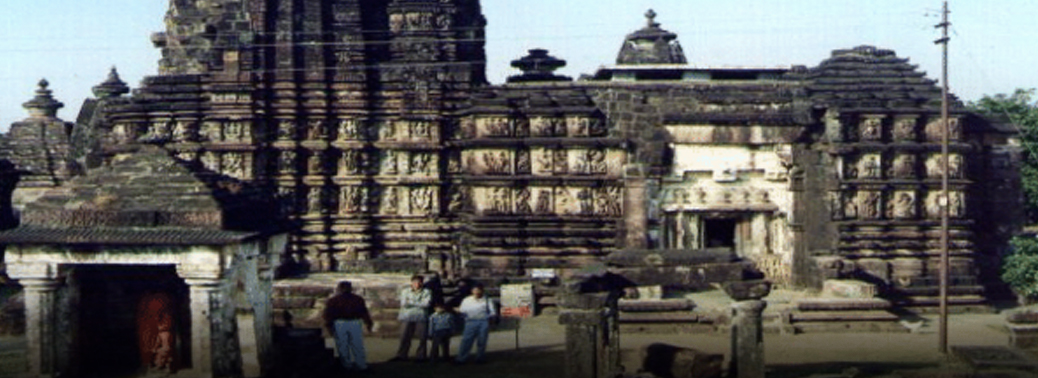
- Context– The restoration work of Markandeshwar temple in Maharashtra by the Archaeological Survey of India Known as the “Khajuraho of Vidarbha”,the temple of Markandadeo is situated on the bank of River Wainganga in district Gadchiroli of Maharashtra.
Features:
- The temples belong to the Nagara group of temples of North India.
- On stylistic grounds, their date ranges in between 9-12th centuries CE.
- The temples belong to saiva, vaishnava and sakta faith.
- Most of the temples have a simple plan, With Ardhamandapa, Mandapa, Antarala and Garbhagriha forming the component of the entire set up.
- Shikhara of the main shrine and mahamandapa was struck by a lightning which led to the partial collapse of the shikhara.
- Nagara style
- The northern-style (Nagara), Shikhara is shaped like a beehive and is made up of layer upon layer of architectural elements called kapotas and gavakshas
Gond Ruler:
- The then Gond Ruler renovated the temple about 120 years ago, trying to restore the fallen portions as much as possible.
JAIPUR CITY DECLARED AS A WORLD HERITAGE SITE
07, Jul 2019
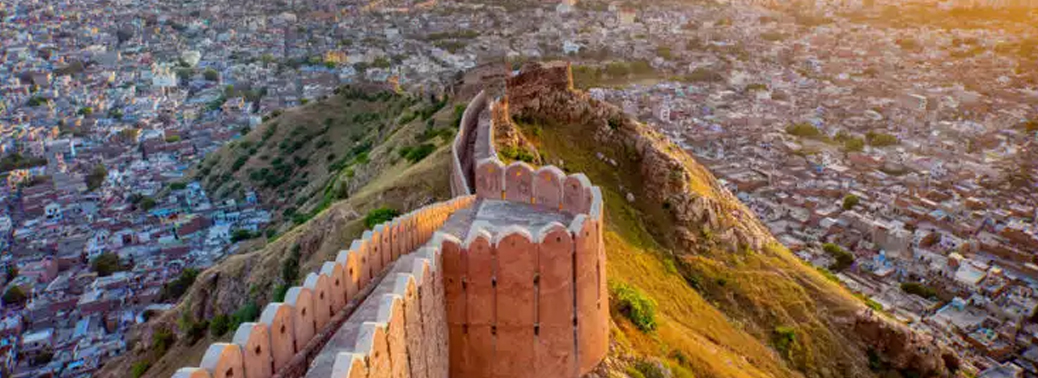
Why in News?
- Jaipur City, Rajasthan got inscribed on the World Heritage List of UNESCO during the 43rd Session of the World Heritage Committee held at Baku, Azerbaijan.
Highlights:
- India’s nomination of the Jaipur City, Rajasthan got inscribed on the World Heritage List of UNESCO during the 43rd Session of the World Heritage Committee held at Baku, Azerbaijan.
- The nomination of Jaipur City has successfully been done by complying with the various UNESCO guidelines of 2017. With Successful inscription of Jaipur City,India has 38 world heritage sites , that include 30 Cultural properties, 7 Natural properties and 1 mixed site. India’s nomination was initially recommended by the ICOMOS (advisory body of World Heritage (WH)Centre for cultural sites) as Deferral, but the 21 nation World Heritage Committee debated it and after discussion decided to inscribe it on the World Heritage list.
Why Jaipur?
- The City of Jaipur is an exceptional urban example in indigenous city planning and construction in South Asia.
- Unlike other medieval cities of the region, Jaipur was deliberately planned as a new city on the plains open for trade as opposed to hilly terrain and military cities of past, though its planning still ensured a response to the surrounding hill tops in all directions.
- The site selected within the valley that lay to the south of Amber hills was comparatively flat and unmarred by any previous construction.
- Besides an exemplary planning, its iconic monuments such as the Govind Dev temple, City Palace, Jantar Mantar and Hawa Mahal excel in artistic and architectural craftsmanship of the period.
- Jaipur is an expression of the astronomical skills, living traditions, unique urban form and exemplary foresighted city planning of an 18Th century city from India.
- Jaipur is an exemplary development in town planning and architecture that demonstrates amalgamation and important interchange of several ideas over the late medieval period.
World Heritage Committee:
- The World Heritage Committee is composed of representatives of 21 States Parties to the World Heritage Convention who meet annually.
- The Committee is in charge of implementing the Convention.
- To date, 1,092 sites in 167 countries have been inscribed on the World Heritage List.
Significance:
- It brings international attention to the need for the preservation and conservation of the site.
- It brings tourism to the site, with its accompanying economic benefits to the host country and local area.
- It can provide funds for restoration, preservation, and training. For example, in 2001, the Taliban destroyed two 6th century, 150-ft. statues of Buddha carved into the mountainside in the Bamiyan Valley in Afghanistan. The site has received more than $4 million from UNESCO to help with reconstruction and to hire a sculptor to re-carve some of the damaged stone.
- It promotes national and local pride in the natural and man-made wonders of the country. It promotes close ties with the United Nations system and the prestige and support it provides.
- It provides access to global project management resources.
- It facilitates creating partnerships between government, the private sector, and NGOs to achieve conservation goals.
- The site is protected under the Geneva Convention against destruction or misuse during wartime.
Selection Criteria:
- To represent a masterpiece of human creative genius
- To exhibit an important interchange of human values, over a span of time or within a cultural area of the world, on developments in architecture or technology, monumental arts, town-planning or landscape design;
- To bear a unique or at least exceptional testimony to a cultural tradition or to a civilization which is living or which has disappeared
- To be an outstanding example of a type of building, architectural or technological ensemble or landscape which illustrates (a) significant stage(s) in human history;
- To be an outstanding example of a traditional human settlement, land-use, or sea-use which is representative of a culture (or cultures), or human interaction with the environment especially when it has become vulnerable under the impact of irreversible change;
- To be directly or tangibly associated with events or living traditions, with ideas, or with beliefs, with artistic and literary works of outstanding universal significance. (The Committee considers that this criterion should preferably be used in conjunction with other criteria);
- To contain superlative natural phenomena or areas of exceptional natural beauty and aesthetic importance;
- To be outstanding examples representing major stages of earth’s history, including the record of life, significant on-going geological processes in the development of landforms, or significant geomorphic or physiographic features;
- To be outstanding examples representing significant on-going ecological and biological processes in the evolution and development of terrestrial, fresh water, coastal and marine ecosystems and communities of plants and animals;
- To contain the most important and significant natural habitats for in-situ conservation of biological diversity, including those containing threatened species of outstanding universal value from the point of view of science or conservation.
Types of World Heritage Sites:
- Cultural Heritage Sites include hundreds of historic buildings and town sites, important archaeological sites, and works of monumental sculpture or painting.
- Natural Heritage Sites are restricted to those natural areas that (1) furnish outstanding examples of Earth’s record of life or its geologic processes, (2) provide excellent examples of ongoing ecological and biological evolutionary processes, (3) contain natural phenomena that are rare, unique, superlative, or of outstanding beauty, or (4) furnish habitats for rare or endangered animals or plants or are sites of exceptional biodiversity.
- Mixed Heritage Sites contain elements of both natural and cultural significance.
Process of getting into the list:
- The first step involves creating a detailed dossier showing the outstanding universal value of the site, besides meeting a few other criteria.
- Once the documentation is complete, it requires a push by the State party or the country where the site is located.
- The property is then evaluated by the International Council on Monuments and Sites (ICOMOS) and the International Union for Conservation of Nature (IUCN).
- The International Centre for the Study of the Preservation and Restoration of Cultural Property (ICCROM) then provides advice on conservation of the site, and training.
- After all these steps, the World Heritage Committee evaluates the site and decides to inscribe it or send back the nomination.
SWADESH DARSHAN SCHEME
05, Jul 2019

Why in News?
- Swadesh Darshan Scheme – Integrated Development of theme-based tourist circuits is the flagship scheme of Ministry of Tourism for development of tourism infrastructure in the country.
- Under Swadesh Darshan Scheme Ministry of Tourism is developing critical tourism infrastructure in the country in a sustainable and inclusive manner to make India into a world class tourist destination.
- The focus under the scheme is to develop public facilities like last mile connectivity, Tourist reception Centers, Way side Amenities, Solid Waste Management, Illumination, Landscaping, parking etc. where Private Sector is not willing to invest.
Objectives:
- Position tourism as a major engine of economic growth and job creation; Develop circuits having tourist potential in a planned and prioritized manner;
- Promote cultural and heritage value of the country to generate livelihoods in the identified regions;
- Enhance the tourist attractiveness in a sustainable manner by developing world class infrastructure in the circuit/destinations;
- Follow community-based development and pro-poor tourism approach;
- Create awareness among the local communities about the importance of tourism for them in terms of increased sources of income, improved living standards and overall development of the area.
- Create employment through active involvement of local communities;
- Harness tourism potential for its effects in employment generation and economic development.
- Make full use of the potential and advantages in terms of available infrastructure, national culture and characteristic strong points of each and every region throughout the country by development of theme-based circuits.
Pandharpur Wari
30, Jun 2019
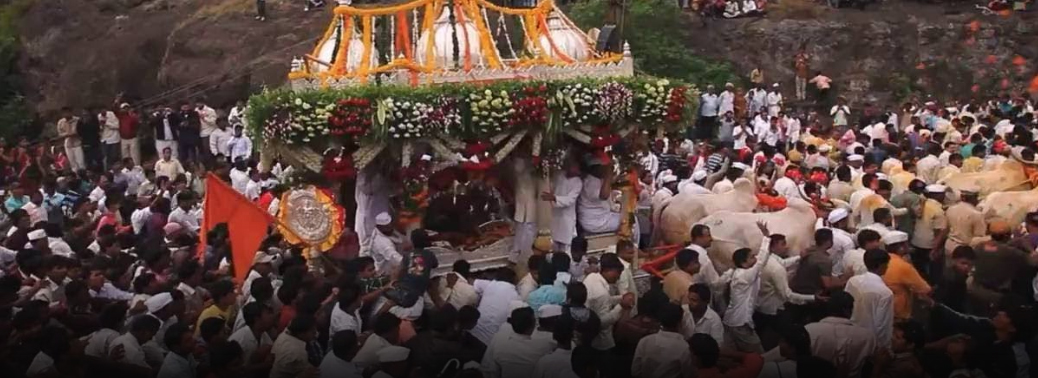
- Pandharpur Wari is related to Bhakti Movment
- It is an annual pilgrimage (yatra) to Pandharpur – the seat of the Hindu god Vithal in
- Palakhis (palanquin processions) carrying the paduka (foot prints) of various saints – most notably Dnyaneshwar and Tukaram – from the Varkari (Warkari, “one who performs the Wari”) sect (which venerates Vithal), are taken from their respective shrines to Pandharpur.
Bhakti Movement
- As a social movement, the Bhakti movement, challenged caste hierarchy, emphasized the individual’s direct connection to god and the possibility of salvation for all through good deeds and simple living.
- In Maharashtra, the Bhakti movement began in the late 13th century.
- Its proponents were known as the Varkaris.
- Among its most popular figures were Jnanadev (1275- 96),Namdev (1270-50) and Tukaram (1608-50), who have left behind many verses that embody the essence of Bhakti.
Tukaram
- Saint of the Bhakti movement in Maharashtra,
- Tukaram is best known for his devotional poetry called Abhanga and community-oriented worship with spiritual songs known as kirtans
- He was part of the egalitarian, personalized Varkari devotionalism tradition
- Tukaram was a rebel from Shudra by caste,
- Defying the injunctions of the Brahmins, Tukaram chose to write on religious matters, and that too in Marathi, the language of the people.
Namdev
- was an Indian poet and saint from Maharashtra,
- writings were also recognized by the “Gurus” of Sikhism and are included in the holy book of Sikhism, the Sri Guru Granth Sahib.
- Namdev was influenced by Vaishnavism.
- His philosophy contains both nirguna and saguna Brahman elements.
Dnyaneshwar
- was a 13th-century Marathi saint, poet, philosopher and yogi of the Nath Vaishnava tradition.
- Dnyaneshwar’s ideas reflect the non-dualistic Advaita Vedanta
- His legacy inspired saint-poets such as and Tukaram
RED FORT
25, Jun 2019
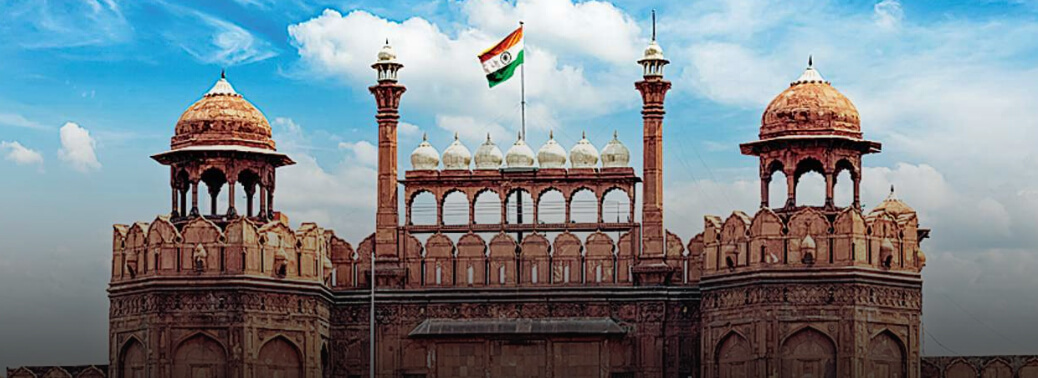
Context:
ASI carries out restoration of Mughal •era parts of Red Fort.
About:
- Red fort fuses architectural styles of the Timurids and the Persians.
- Red Fort has many structures that serve as fine examples of Islamic architectural style and Mughal architecture,
- Built By: Shah Jahan
- Architect: Ustad Ahmad Lahauri Architectural styles: Mughal, Indo-Islamic Current Status: UNESCO World Heritage Site On the Banks of River Yamuna,
- The Red Fort is known for its gardens and a water channel called The Stream of Paradise.
Salient Features of Indo-Islamic Architecture:
- Islamic Architecture is characterised by a few Visible Symbols.
- One is the arch, which frames the space;
- second symbol is the dome, which looms over the skyscape;
- third is the Minaret, which pierces the skies. Minarets were Actually Symbols in the Middle of Deserts
- Muslims forbidden to replicate living forms on any surface, developed their religious art and architecture consisting of the arts of arabesque, geometrical patterns and calligraphy on plaster and stone.
Indian Indo Islamic Architecture:
- The Indo-Islamic architecture inculcates the elements of Saracenic, Turkish and Arab architecture
- The first new element added in the Indian architecture was the use of shapes instead of natural forms. This apart, use of calligraphy as inscriptional art was also a new element added to by Muslims
- Inlay decoration and use of coloured marble, painted plaster and brilliantly glazed tiles.
Indo-Islamic architecture is conventionally categorised into the following four Categories:
- Imperial Style (Delhi Sultanate)
- Provincial Style (Mandu, Gujarat, Bengal, and Jaunpur)
- Mughal Style (Delhi, Agra, and Lahore)
- Deccani Style (Bijapur, Golconda).
The Building Material:
- One thing is very common in these buildings that the walls are extremely thick and largely constructed of Rubble masonary, which was easily available.
- These walls were then cased over with limestone plaster or dressed stone.
- A variety of stones were used such as Quartzite, Sandstone, Buff, Marble, etc. In some cases, the Polychrome Tiles were used to finish the walls.
5th INTERNATIONAL DAY OF YOGA
21, Jun 2019
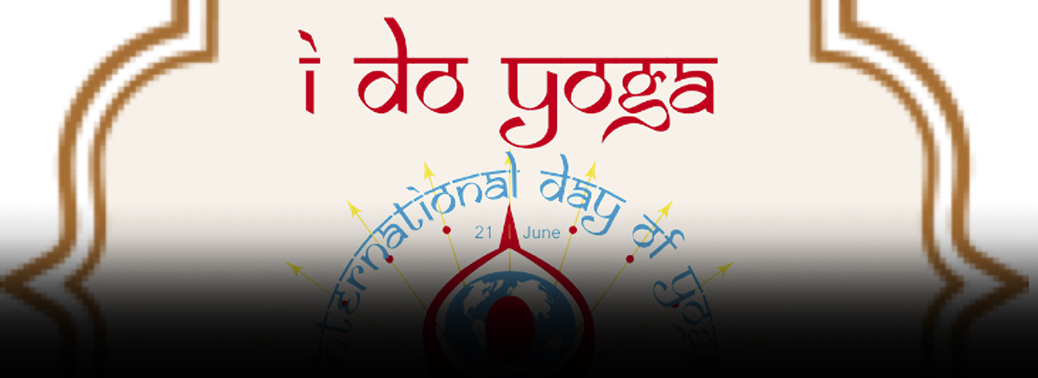
- International Day of Yoga, is celebrated annually on 21 June every year since 2015.
- International day for yoga was declared unanimously by the United Nations General Assembly (UNGA).
- It was inscribed in the representative list of Intangible Cultural Heritage of Humanity by UNESCO in December 2016.
About YOGA:
- Yoga, a school emphasizing meditation, contemplation and liberation.
- Yoga is an ancient physical, mental and spiritual practice.
- The Yoga philosophical system is closely allied with the Samkhya school, but is more theistic than the Samkhya.
- The foundational text of the Yoga school is the Yoga Sutras of Patanjali, who is regarded as the founder of the formal Yoga philosophy.
Hindu philosophy distinguishes seven major branches of Yoga:
- Raja Yoga (Classical Yoga), a system of yoga codified by Patañjali and classified as one of the six āstika (“orthodox”) schools of Hindu philosophy.
- Jnana yoga, (buddhi-yoga) centred on the faculty of discernment and ‘virtually identical with the spiritual path of Vedānta’.
- Karma-yoga, in which the world of everyday work becomes the tool by which self is transcended.
- Bhakti-Yoga the path of devoted service to God.
- Tantra-yoga focused on the techniques and psycho-physical teachings contained within a body of texts called tantras.
- Mantra-Yoga, one of the most ancient forms of yoga in which the psycho-acoustical properties of the spoken word are used to concentrate the mind.
- Hatha Yoga, a system of physical purification designed to reintegrate and re-balance the mind and body in preparation for Raja-yoga (first described by Yogi Swatmarama).
NILGIRI TRIBALS TENSE AS TREKKERS TRASH PRICELESS ROCK ART
03, Jun 2019
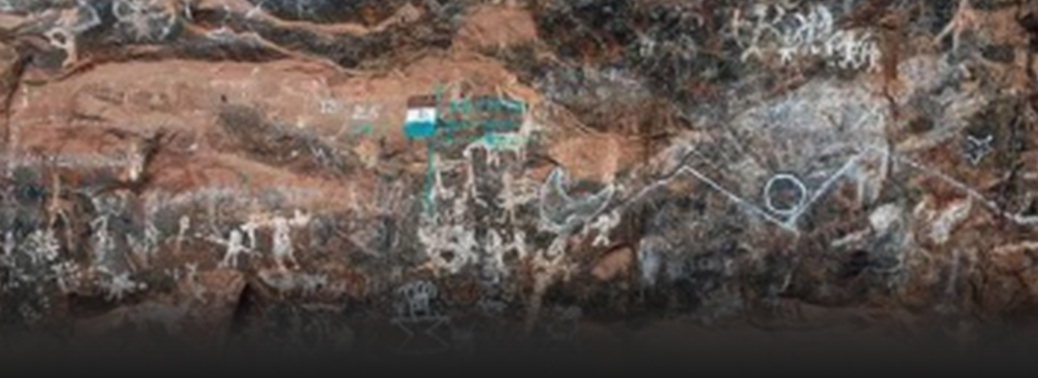
Why in News:
- The rock paintings in Karikiyoor at Kil Kotagiri in the Nilgiri forests have withstood the forces of nature for some 5,000 years, but in just the last few years, close to 40% of the paintings have been destroyed by trekkers, tourists, and vandals.
Details:
- Members of the Irula tribal community, who have an ancestral link to the site, said they were “extremely angered” and “disturbed” at the damage by illegal trekkers, permanently disfiguring the priceless pre-historic site.
- They enter the site without permission.
- The site remained undisturbed till very recently, when a spurt in the number of tourists has led to many people organising illegal treks to the rock art site,”
- The society that painted the symbols onto these rocks were contemporaneous with the Indus Valley civilisation.
- “The rock paintings in Karikiyoor contain analogous-Indus script, meaning they resemble the script found in Indus civilization sites of northern India.
- Sites such as Karikiyoor need to be preserved to better understand the people that lived in the region, while also possibly deducing how certain technology and written scripts could have possibly diffused to southern India from the Indus peoples or vice versa.
- The rock paintings serve both, as a “historical record,” detailing the hunting habits and
ways of life of the local communities, and also a ritualistic purpose. - Irulas have a deep cultural connection to the site, believing that their ancestors were the ones who had painted the symbols. Failure to act will lead to the destruction and eventual loss of the site forever.
Irula Tribe:
- The Irula tribe, one of India’s oldest indigenous communities, lives along the borders of Tamil Nadu and Kerala.
- Irulas are specialists in traditional herbal medicine and healing practices, and Irula ‘vaidyars’ (practitioners of any Indian systems of medicine) are mostly women and practice traditional healing systems which use over 320 medicinal herbs.
India bans Jamaat-ul-Mujahideen Bangladesh terror outfit
27, May 2019
- 27 May 2019 Current Affairs: Jamaat-ul-Mujahideen Bangladesh also called as Jamaat-ul-Mujahideen India or Jamaat-ul-Mujahideen Hindustan declared as a banned terrorist organization by the government, the Home Ministry
- In a notification, the home ministry said the outfit has committed acts of terrorism, promoted acts of terrorism and has been engaged in radicalization and recruitment of youths for terrorist activities in India.
- The Jamaat-ul-Mujahideen Bangladesh or Jamaat-ul-Mujahideen India or Jamaat-ul-Mujahideen Hindustan and all its manifestations have been inserted in the First Schedule to the Unlawful Activities (Prevention) Act, 1967.
PLUG AND PRAY: PARSI PRIESTS GO HIGH TECH
22, May 2019
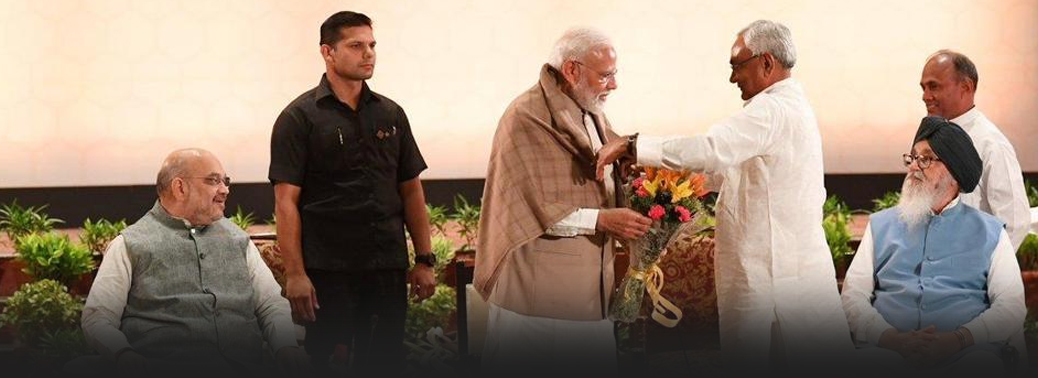
Why in News:
- The Parsi community is innovating to save its age-old traditions due to decline in its population.
Background:
- It has digitised its prayers, and Parsis can now plug in their earphones or tap their phone screens to learn them. The range covers advanced ones recited by priests to everyday chants for households.
- The exercise aims to not just improve access for the young and the elderly, but to provide a reference for priests.
Who are Parsis:
- Zoroastrianism is the pre-Islamic religion of Iran which survives today in small pockets in Iran and to a larger extent in India. Today, the descendants of the Zoroastrians are called Parsis in India. Zoroastrianism is one of the oldest religions in the world.
- Zoroastrianism was founded by Iranian prophet and reformer Zoroaster or Zarathustra. He lived before the 6th century BC. He was born into a polytheistic religion and was a priest. He rejected the prevailing religion of the Bronze Age Persians because of its class structure and many gods. He was also against animal sacrifices and the usage of the Haoma plant (Vedic Soma plant) in rituals.
Zoroastrianism Beliefs
- Zoroastrianism is a monotheistic faith. One of its core principles is the dualistic cosmology of good and evil. Zoroastrianism believes in a supreme deity of wisdom called ‘Ahura Mazda’. Other features of Zoroastrianism are messianism, heaven and hell, judgment after death, free will, etc. It has influenced other religions like Christianity, Second Temple
- Judaism, Buddhism, Islam and Gnosticism. The religion rejects all forms of monasticism. It believes in the soul but not in reincarnation (although a sect in India called Ilm-e-Kshnoom does believe in reincarnation). Water and fire are considered elements of ritual purity. These two elements are very important for Zoroastrians. A Zoroastrian place of worship is called a Fire Temple.
- The holy book of Zoroastrianism is called the Avesta. It is a collection of sacred scriptures and contains the Gathas, which is considered the core of the Avesta. Zoroaster is believed to have composed the Gathas himself.
Zoroastrianism in India:
- After the Islamic conquest of Persia in the 7th century CE, the Zoroastrianism religion gradually declined in its country of origin. By the 11th century, most of the Iranians had become Muslims. Currently, they are a small minority in Iran.
- Today, India is the home of the largest Zoroastrian population in the world. Facing Islamic onslaught of conversion and discrimination in their homeland after the Islamic invasion of
- Iran in the 7th century onwards, many Zoroastrians migrated to Gujarat in India. Their descendants are now called Parsis (meaning Persian in Gujarati). Today, there are less than 70,000 Parsis in India because the community has a dwindling growth rate. Although less in number, they are a highly successful group.
ASI IDENTIFIES INDIAN ARTEFACTS SEIZED FROM SMUGGLER
09, May 2019
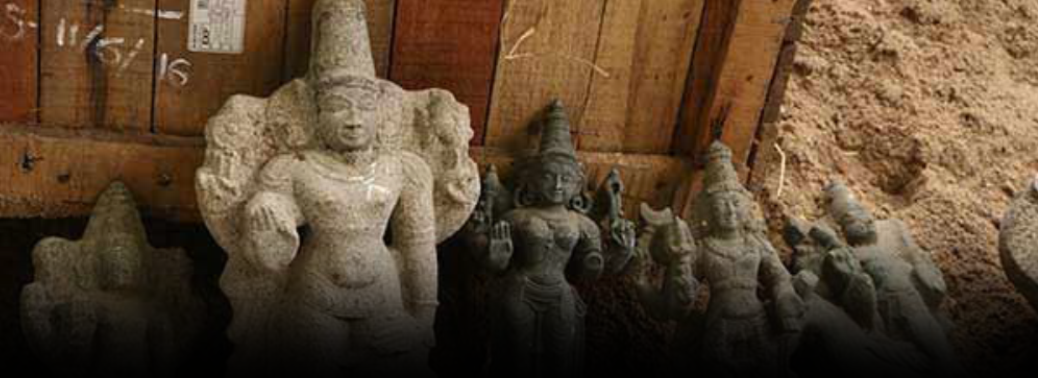
Why in News:
- From idols dating back to the Gupta period (5th-6th Century AD) to terracotta objects of the Harappan culture, a range of Indian antiquities and artefacts that were smuggled identified by the Archaeological Survey of India (ASI) during a team’s recent visit to the United States.
Details:
- “The antiquities comprise beautiful bronzes from the Suttamalli and Sripurantan temples of
- Tamil Nadu and also a very significant image of Mahakoka Devata.
- Of these, four antiquities were stolen from the protected monuments at Karitalai, district Katni in Madhya Pradesh.
- Apart from that, 56 terracotta objects that were returned by Toledo Museum in Ohio to the Indian consulate were declared to be antiquities by the team.
- Among them, few were identified as antiquities, like the stone image of the Buddha of Mathura School, a terracotta image of the Buddha belonging to the Gupta period and a set of 10 copper plates engraved with Quranic verses of the late Mughal Period,
Archaeological Survey of India (ASI)
- The ASI is the premier organization for the archaeological researches and protection of the cultural heritage of the country.
- The prime objection of ASI is to maintain the archaeological sites, ancient monuments and remains of national importance.
- Headquarters: New Delhi.
- Established: 1861 by Alexander Cunningham.
- It regulates all archaeological activities as per the provisions of the Ancient Monuments and Archaeological Sites and Remains Act, 1958.
- It functions under the aegis of the Union Ministry of Culture. It also regulates Antiquities and Art Treasure Act, 1972.
KOLAM TRIBE
09, May 2019
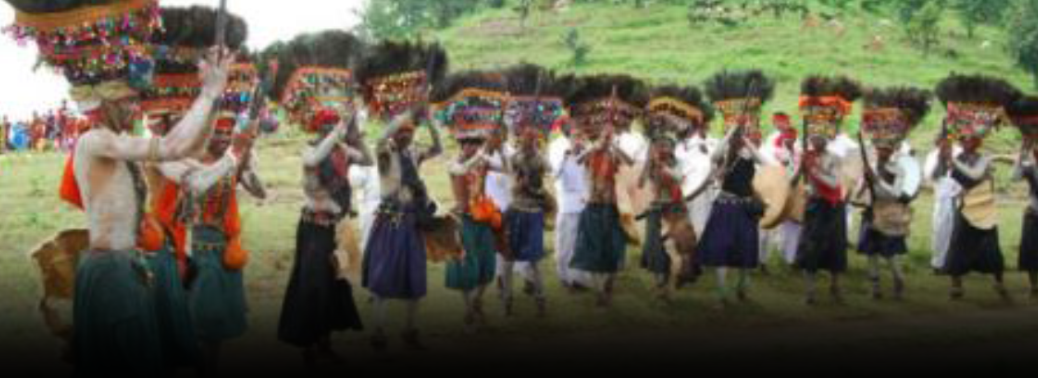
Why in News:
- Four children belonging to the aboriginal Kolam tribe from Narnoor mandal in Adilabad district died after food poisoning
Details
- Kolam are a designated Scheduled Tribe in the Indian states of Andhra Pradesh Chhattisgarh Madhya Pradesh and Maharashtra.
- They belong to the sub-category Particularly vulnerable tribal group, one of the three belonging to this sub-category.
- They speak the Kolami language, they are an agricultural community. The Kolam are an endogamous group.
- They have a high rate of returning positive to the Naked eye single tube red cell osmotic fragility test (NESTROFT) test, making them prone to high incidence of Thalassaemia.
Government initiative for tribes:
- The Tribal Sub Plan (TSP) strategy is a Government of India initiative aimed for the rapid socio-economic development of tribal people.
- The National Commission for Scheduled Tribes is vested with the duty to participate and advise in the planning process of socio-economic development of STs, and to evaluate the progress of their development under the Union and any State.
UN.ORG International Dance Day: 29 April
30, Apr 2019
CONTEXT:
- April 29 is celebrated as International Dance Day annually.
- It aims to bring people together with a common language – dance.
- In 1982, the Dance Committee of International Theatre Institute founded International Dance Day & theme for 2019 is Dance and Spirituality.
KARBI ANGLONG
21, Apr 2019
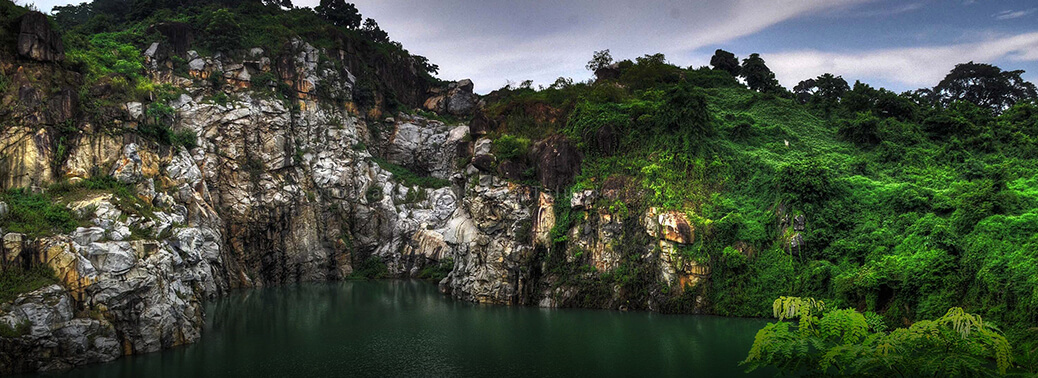
Why in news:
- Karbi people taking out a procession on the occasion of gohain uliuwa mela
Background:
- Karbis belong to the Mongoloid group and linguistically they belong to the Tibeto-Burman group. The original home of the various people speaking Tibeto-Burman languages was in western China near the Yang-Tee-Kiang and the Howang-ho rivers and from these places they went down the courses of the Brahmaputra, the Chindwin and the Irrawaddy and entered India and Burma. The Karbis, alongwith others entered Assam from Central Asia in one of the waves of migration.
- The folk-lores of the Karbis, however, indicate that during the long past, once they used to live on the banks of the rivers the Kalang and the Kapili and the entire Kajiranga area, the famous National Park situated in Assam, was within their habitation. During the reigns of the Kachari kings, they were driven to the hills and some of them entered into Jaintia hills, the erstwhile Jaintia kingdom and lived under the Jaintia suzerainty.
- While a section of the Karbis remained in the Jaintia kingdom, others moved towards north- east by crossing the river Barapani, a tributory of the Kapili and entered into the Rongkhang Ranges. There they established their capital at a place called SOCHENG. The Karbis who migrated to the Ahom kingdom had to face the Burmese invasion.
- The Burmese who invaded Assam perpetrated inhumane oppression on the people. The Karbis took refuge in the deep jungles and high hills leaving their hearth and home in the submountane regions. In order to save themselves from the greedy eyes of the Burmese invaders, the young Karbi girls started to use a black line from the forehead to the chin which is known a “DUK” with a view to making them ugly looking. While some of the Karbis migrated to lower Assam, some had crossed the Brahmaputra and settled in the north bank.
- The Karbis have 5(five) clans called “KUR”. These are Terang, Teron, Enghee. Ingti and Timung. Each of the five clans has a number of Sub-clans. While Enghee and Timung have 30(thirty) sub-clans each, Terang have 15(fifteen) sub clans, Teron have 9(Nine) sub-clans , and the remaining clan Ingti has only 6(Six) sub-clans. These clans are completely exagamous and marriage between a boy and a girl belonging to the same clan can never take place since the children of the same clan are considered as brothers and sisters. Violation of this customary law obviously leads to ex-communication of the couple involved. Even in the cremation ground called Tipit or Thiri, area is kept demarcated for each clan. Although all the five clans are socially on an equality, Ingti being a priestly clan was supposed to have a higher status in former times.
- Although, monogamy is the prevailing practice, there is no bar to polygamy and the cases of polygamy are very rare. Cross-cousin marriage is a preferential one. Like other tribal societies, the Karbis do not have the system of bride price. After marriage, the wife
- continues to use the surname of her father. But the children assume the title of their father. Thus, the Karbis follow the patriarchel system of family structure.
- The settlement pattern of the Karbis is in the form of a village. Each village has a headman called Gaonbura or Sarthe who is appointed by the authority of Karbi Anglong Autonomous Council. But each revenue village has a number of hamlets situated kilometers apart. Each of the such hamlets has also a Gaonbura. Each Karbi village is named after the Gaonbura. The Karbis, like the other hill tribes, have a tendency to live on the hill tops. The Karbis who practice jhuming or shifting cultivation very often shift their villages to new jhum sites which might be 10 to 20 kms away from the present site.
- Among the festivals observed by the Karbis, mention may be made of the “Chojun Puja” or “Swarak Puja” ;”Rongker”; “Sok-keroi”; “Hacha-Kekan”, “Chomangkan”etc.While the former four festivals are socio-religious in nasture and the letter is a social one.
- The spot for “Chojun Puja” or “Swarak Puja” is generally selected near the house of the family which wishes to perform the puja. The deities in this festival are Barithe, Shar Arnam, Arni and the Devil Hii-i and other smaller Gods. Hemphu, the greatest God of the Karbis is also propriated.The puja is peformed for the welfare of the family.
- The Karbis have their traditional dresses which are artistically designed. These dresses are woven at their family looms.There are separate dresses for men and women.
- The aged men use an artistically designed shirt called Choy-nangpo and the shirt used by the young men is called Choy-hongthor. The men use a loin cloth called Rikong.
- The Karbi women and girls generally use Pinicamflak, a piece of cloth tied around the waist like a Mekhela. A piece of artistic cloth is used by them to cover the upper part of their body and it is called Pe-kok. A very highly artistic waist band called Wankok is also used by every woman and girl. The ladies use coloured and striped Endi scarf called Khongjari during winter
The Dumrali Karbis
- Those Karbis residing in the plains of Kamrup and Morigaon district of Assam, and the Ri- Bhoi districts of Meghalaya identify themselves as the Dumrali or plains Karbis. With their social head at Dimoria, culturally and customarily they have different sets of social behavior and functions to their counterpart at Karbi Anglong. Linguistically they are a sub group of Mikir groups of the greater Tibeto-Burman family and class as Amri (the other being Karbi) in the latest grouping of the T-B family. The field work was undertaken at Mermain (aka. Marmé) (26º E and 90° N); a village at the border of Meghalaya and Assam. The village is divided between these two states as half the village is in the other side of the political boundary.
- 40 % of the population in Ri-Bhoi district of Meghalaya consists of Karbis, amongst whom about 60 % profess their religion to be Christianity, and the rest are of traditional religion. You will come across some unfamiliar clans among the populaces like Klien, which is claimed to be the another version of Killing, a sub clan of Tungjang (Timung), and Rongson or Rongchon, which is not different from Ronchehon , a sub clan of Ejang (Ronghang) as claimed by the local population besides Longthulu, Tron and Tumung.
- The priest is usually the head of the house; he is assigned the name Penpo which is similar to Pinpo of the Hills Karbis. Amongst the Plains Karbis there are basically three main social festivals:
1) DOMAHI
- It is celebrated in the months of March-April. It is a festival of thanks giving to the almighty Hemphu, the traditional god head of the Karbi Household. Each member of the social setup of the village is known as MEKAR, which might be the origin of the word MIKIR as the tribes were known till very recently and in fact still do in some of the official documents. However this is just a hypothesis I would like to go more deeply into. During the festival all the ancestors of the village are remembered and worshipped, which is indeed very similar to the practice of their hills cousin. This practice is known as SAR-KACHERDUNG.
2) MONO KE-EN
- Literally Mono means Paddy or Rice and Ke-en means to take. It is generally an affair of 2 days, once in five years. All unmarried males and females of the village are to take part in the occasions. In the house of Riso Bangthe (an authority concern with the affairs of the youth of the village) the traditional folklore about the origin of rice and the route of migration taken by the Karbis from the place of their origin are retold. It is very much the same story which is told amongst the Hills Karbis (Mosera-Kihir) but with the name ‘Karbi Kevang’ .Karbi Coming” with some addition like the reason for the Karbis to start moving out from their ancestral village somewhere near Inglong Kelok “.Mountain White” , which is unmistakably the Himalaya mountain range. There is a mentioned of Lhasa also on the way. The mentioning of KLENG MEKAR, on whose head a flame of fire always glow to lead the Karbis during darkness is intriguingly interesting and to be noted. He is not mention anywhere in Mosera-Kihir, the hill version. Terang were supposed to be the porter who carried all the essential items needed for the whole village. The reason mentioned for the Karbis to move out of the ancestral village is also very interesting. It is said that the Karbis
- being very poetic and romantic once tried to touch the moon and play with it, seeing it stationed beautifully on the top of the INGLONG KELOK. But when they climbed up to the top of the mountain and found the moon to be still afar and unreachable, then only did they realized their mistake. Since they felt ashamed to return to their ancestral village they decided to move forward towards the east and settled down somewhere else, which is not found in MOSERA-KIHIR. The mention of the river TERON LONGSO, where the TERON with divine power helped the others to cross a river with huge width by stretching himself like a bridge is also very interesting, which has again no mention in Mosera-Kihir with the exception of the river TERON LONGSO, where the paddy was supposed to be discovered by the Karbis which coincide very much with the version of the hills Karbis.
3) RONG KEHUM
- Literally Rong Kehum means Village Curfew. It is generally a three days affair once in five years. Just like the name suggested a kind of curfew is imposed in the village with all the roads leading to the village being blocked with thorn and bushes. No outsider is welcome to the village during these three days affair. However they can come and witness the ritual by taking non-traditional route. This festival is generally celebrated during the winter. It is very much similar to the Rongker of the hills Karbis. This is all male affairs and no female is allowed during the rituals. The fences are broken and lots of hue and cry is created during the rituals as a symbol to chase away evils from the village during the night using a long stick. If any person comes out of the house during the ritual then he might be killed assuming to be an evil spirit and no blame is to be confer upon the evil spirits chasers.
A DIALOGUE WITH OUR FRAGILE PAST
20, Apr 2019

Why in News?
- The world needs to look differently at its historical memory and the cultural heritage which embodies it
Details:
- The large fire that broke out in Paris on Monday and which consumed a part of the Cathedral of Notre-Dame, is a grim reminder that centuries of heritage can be destroyed in minutes.
- of course, the French people can rebuild the physical structure
- and, in this enterprise, they will be certainly supported by the vast wealth of Europe, America and others, made possible by centuries of industrialisation and capital accumulation. But rebuilding the Notre-Dame de Paris does not mean that we can necessarily renew its original spirit — of blocks of sandstones which narrate their own geological and social history. Undoubtedly, for over 800 years, the cathedral has been the driving force behind the eternal return of Paris as the ‘Heart of the World’.
Repository of history
- As a powerful spiritual symbol of Christian faith, it counts many treasures, such as the crown of thorns, which are believed to have been placed on Jesus Christ’s head.
- Joan of Arc was beatified in the cathedral in 1909, after her execution for heresy in 1431. And, for more than three centuries, Notre-Dame has stood as a symbol of political change in France. During the French Revolution, its treasures were plundered. However, as seen in the famous painting of Jacques-Louis David, Napoleon Bonaparte crowned himself emperor of France at Notre-Dame in 1804. Other famous political ceremonies of the 20th and 21st centuries in France, such as the liberation of Paris from Nazi occupation in 1944, the farewell to Charles de Gaulle in 1970, and a requiem mass in tribute to François Mitterrand in 1996, took place in the Notre-Dame Cathedral.
- Last but not least, for nearly nine centuries, Notre-Dame has been at the centre of French and world literature
Spirit of freedom
- Without the stones of Notre-Dame, these aesthetic compasses, we would never be able to take our responsibilities in the world. For centuries, humanity has witnessed the destruction of its historical memory, and each time a new door to our common fate is closed forever.
- We all believe that this should not happen anymore. But it does happen, and we cannot reconcile ourselves with it. Heritage, therefore, expresses a joy of witnessing the past despite the sadness of historical destruction. It is this joy of witnessing the past that becomes an awareness of our landscape of memory. This awareness is the strongest evidence of the victory of peaceful coexistence between the past and the present.
CHENCHUS BELIEVE THE FOX USHERS IN FORTUNE
18, Apr 2019

Why in News:
The nomadic tribal families have succeeded in domesticating the animal
Details: / An offence: official
- Senior official at the Srisailam Nagarjuna Sagar Tiger Reserve Nageswara Rao said: “The conservation of fox falls under the Indian Wildlife Protection Act 1972,
- according to which hunting or domesticating it is an offence and attracts punishment.
Chenchu Tribes:
- Chenchus are a Particularly Vulnerable Tribal Group whose hamlets or Pentas dot the Nallamala forest range spread across four to five districts in Telangana and Andhra Pradesh states. They are inveterate forest dwellers, who have, over centuries, steadfastly refused to move out of their woods regardless of the perils of such life.
- If patriotism be defined as love for the land, Chenchus are patriots in true spirit.
- The non-resident war cries on social media over imagined boundaries are no match for their raw affinity to forests where they live without basic facilities.
- They are among the oldest living aboriginals of south India.
JAT VOTES
18, Apr 2019
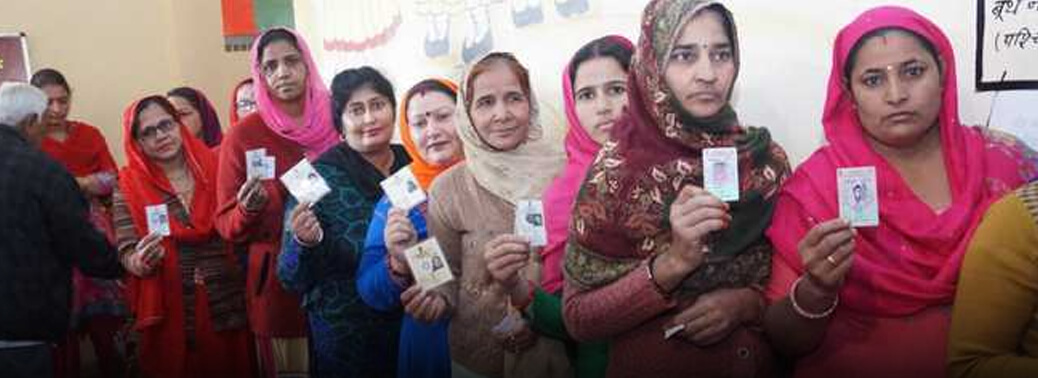
Why in News:
- In Which way will the Jat votes swings-the question hangs in the air.
Background:
- The Jats are a dominant farming community who own their land. The Jats have a reputation of being a feisty, hardworking people who are dedicated to community service. The word Jat is derived from Jatta, a generic term for cattle grazers and camel breeders, moving in a group or federation – jatha.
- They have been known as zamindars (landowner) since the Mugul emperor, Akbar’s reign in the 16th century. Other occupations pursued by the Jat are animal husbandry, transport business, trade, and government and private service, and are teachers, doctors, engineers and surveyors.
Origin
- There are many theories about the history of the Jat. Classical Greek historians Pliny and Ptolemy, trace the migration of the Jat from the banks of the Oxus River to India about a century before Christ. Colonial historians Vincent Smith and James Todd identify them as belonging to the Indo-Scythian hordes that invaded India between 200 BC and 600 AD, and finally settled there. Other scholars such as Ibbetson, Rose and William Crooke believe the Jat to be one of the Rajput tribes. Current research suggests that the Jat migrated from central Asia in the 2nd millennium BC onwards. They spoke Indo-Aryan languages and are believed to be one of the most ancient people in India. They settled along the Indus River in the fertile plains of the Punjab and became a pastoral and peasant community. They united to form a network of councils that linked the clans into villages. Some Jats in Gujarat are Muslim and are pastoral people.
Location
- The largest concentrations of Jat are in the districts of Gujranwala Multan, Muzzaffargarh, Manipuri, Bahawalpur, Patiala and Faridkot in Punjab and Rohtak and Mahendranagar in Haryana. They also live in Mirpur in Kashmir, Uttar Pradesh, Rajasthan, Gujarat, Himachal Pradesh, Madhya Pradesh, Delhi and the union territory of Chandigarh.
What Are Their Lives Like?
- As farmers, the Jat’s main natural resource is the land that they own. During the second half of the nineteenth century the British laid an extensive canal irrigation system in Uttar Pradesh and Punjab which greatly benefited the Jat. Since India’s independence, in 1947, they have become the countries chief producer and supplier of food grains. Their links with local and regional markets are direct and fully regulated.
- The Jats also practice animal husbandry and work in the transport business and trade. They work as bus conductors, truck and taxi drivers or as professionals. The strong presence of the Jat in the Indian army, paramilitary and police forces reinforces their reputation as courageous people. A few Jat, as those in Himachal Pradesh, practice sericulture (the production of raw silk by raising silk worms) as a supplementary occupation.
- The Jat is traditionally vegetarians whose staple food consists of wheat, maize, lentils, vegetables, milk and milk products. Lassi, a yoghurt drink is part of their daily diet. Meat mainly chicken and lamb is eaten on special occasions. They do not eat pork or beef. Muslim Jats eat female buffalo meat. Men drink alcohol.
Customs
- Both extended and smaller families exist. Married women used and sometimes still observe purdah (cover their face with a veil) with their elder brother-in law and father-in-law. The Jat women are consulted in all important matters but men make the final decision. In rural areas they assist the men in the fields, look after the animals along with household duties. City women work in a variety of professions.
- The women are good at embroidery (they are famous for phulkari – embroidered sheet that brides were wrapped in), weave, sew, crotchet and knotting. Charpais (bed) are intricately strung. Jhumar and gidda are energetic folk dances performed by women at weddings. Another dance, the bhangra has been made famous by Bollywood.
What Are Their Beliefs?
- The Jat are predominantly Sikh and also Hindu or Muslim, the last being a small number mainly living in the Kutch district of Gujarat. The Hindu Jat worship all Hindu gods and goddesses, but Shiva is considered to be one of their most ancient ancestors and is the Jat’s most venerated deities. Shiva’s son, Kartikeya, whose mount is a peacock is also worshipped. They participate in all Hindu festivals, as well as visit Hindu sacred places such as Haridwar, Varanasi and Badrinath. Most of the Hindu Jat invariably touch mother earth when they get up in the morning, wish Ram Ram to others, and invoke the sun god (Surya) when they start ploughing their fields.
- The Jat Sikhs were converted to Sikhism in the 16th century during the time of the fifth Sikh Guru Arjun Dev. Though the Jat Sikh worship the Sikh religious book, Guru Granth Sahib, and staunchly adhere to all the tenets of Sikhism, many of them also visit Hindu pilgrimage centres. Sikhs believe in a universal god who is not worshipped as an idol.
- Among the Hindu and Sikh Jat a form of ancestor worship, called Jathera is quite common. The name given to the Jathera is generally of an influential ancestor or the founder of the clan who was a martyr. This place identified with the ancestor is marked by a mound of earth or perhaps a concrete shrine. The Hindu revivalist, as well as purification movement, Arya Samaj, with its protestant ethic and democratic functioning gave the Jat unfettered access to the sacred Hindu scriptures (Vedas) without the mediation of priests, and has been a major factor in the modernisation of the Jat. The egalitarian Radhasoami sect has many followers with many prayer halls scattered throughout Jat inhabited regions.
What are their Needs?
- The Jats of India need clean drinking water and proper health care facilities. Medical teams and aid workers are needed to work among them. The Jat are a relatively affluent community. They have an active social conscience which they put into practice by helping the community. They can be very influential in bringing about change in communities.
CATHEDRAL BLAZE
17, Apr 2019
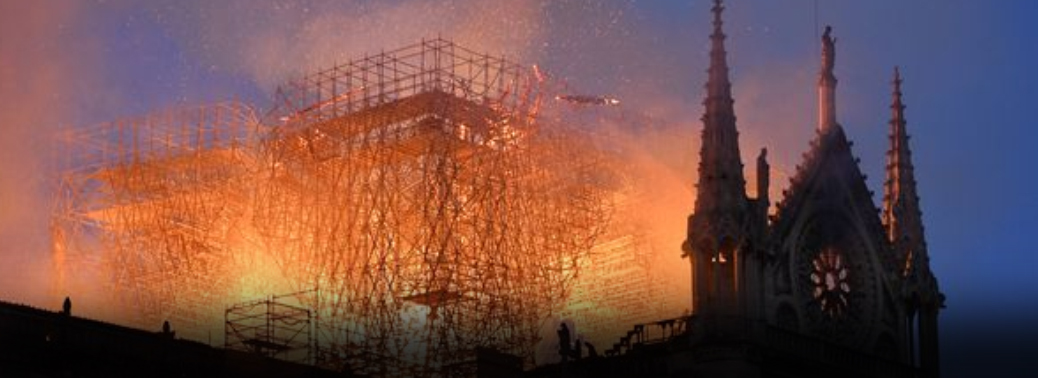
Why in News:
- Notre-Dame cathedral got fire; it was probably by accident says French prosecutors.
Background:
- Notre-Dame in Paris is famous for its intricate gothic-style design and for its aesthetic grandeur and harmony.
Neo-Gothic Style:
- The neo-Gothic style was a revival of the early Gothic style of architecture which had its roots in buildings, especially churches, built in northern Europe during the medieval period. It was characterised by high-pitched roofs, pointed arches and detailed decoration.
In India-gothic style
- This style was adapted for building infrastructure in Bombay. An impressive group of buildings facing the seafront including the Secretariat, University of Bombay and High Court were all built in this style.
- Many Indians merchants gave money for some of these buildings. They were happy to adopt the neo-Gothic style since they believed it was progressive and would help make Bombay, a modern city.
- The British invested a lot in the design and construction of railway stations in this style, an example of which is Chhatrapati Shivaji Terminus in Mumbai.
Important Holy Relics In The Cathedral:
- Holy Crown of thorns-crown as well as tunic is worn by 13th centur7y king, louis IX A piece of the cross on which Jesus was nailed and one his nails.
History behind this church:
- Construction began in 1163 after Pope Alexander III laid the cornerstone for the new cathedral.
- By the time of Bishop Maurice de Sully’s death in 1196, the apse, choir and the new High Altar were all finished, while the nave itself was nearing completion. In 1200, work began on the western facade, including the west rose window and the towers, all of which were completed around 1250, along with a new north rose window.
- Also during the 1250s, the transepts were remodelled in the latest gothic style
Gothic Cathedral Builders:
- With the aid of only elementary drawings and templates, master stone masons meticulously directed the construction of the great medieval cathedrals of Europe. The practices of intuitive calculation, largely based on simple mathematical ratios and structural precedent, were closely guarded and passed between successive generations of masons. Specific site conditions and the insatiable demand by church authorities for higher and lighter buildings provided the impetus for continual development.
LIPSTICK SEED’S GROWN BY TRIBAL’S
15, Apr 2019

Why in news:
- The coloured cosmetic that they adorn on their lips can be manufactured from the non- carcinogenic lipstick seed cultivated in the backyard of Adivasi habitations in Rampachodavaram, Chaparai, and Maredumilli in Andhra Pradesh.
Background: / Who are Adivasis?
- Adivasis are not a homogeneous group; there are over 200 distinct peoples speaking more than 100 languages, and varying greatly in ethnicity and culture. However, there are similarities in their way of life and generally perceived oppressed position within Indian society. According to the official Census held in 2001, Adivasis constitute 8 per cent of the nation’s total population, over 84 million people. Unofficial figures vary significantly but represent a much higher proportion of India’s population. Adivasis live throughout India but are primarily based in the mountain and hill areas, away from the fertile plains.
- According to the 2001 census, the greatest concentration is in Chattisgrah (38%), Jharkahand (26%) Madhya Pradesh (20%), Orisssa (22%), Andhra Pradesh (6%) Gujarat(15%) Rajasthan (12%), Maharashtra (9%) and Bihar (0.9%).
Problems Faced By Adivasis
- Many governments sign MoU’s with big mining corporations without the consent of the tribals who live on the land. Setting up mines and factories inside jungles requires displacing and relocating the tribal population. Most Adivasis do not want to relocate to a different place and prefer living in the jungles. They generally do not value money. Their refusal to vacate the land leads to the government deploying armed forces like the CRPF against them – often burning villages, harassing people, killing tribals – all in an attempt to get them to vacate. This conflict leads to Maoists leading an armed struggle against the government. They claim to be fighting for the rights of the tribals.
- Governments should make public all MoU’s signed with all the mining corporations. This information should be available publicly, with details like the exact location of the proposed mine/factory, which mineral is being mined, which corporation has been awarded the contract, how much money the government and the corporation stand to make etc Governments must take consent of the tribals living on the land before signing any MoU with any corporation. The method of consent must be transparent, without coercion and documented. The government must give up any proposed projects for minerals if tribals do not consent to the mining. The Tribals often are malnourished and lack access to basic healthcare. Anaemia is a common disease among the tribal populations.
- Tribals are often considered “low”, “dirty” by people from the towns, cities, upper castes. They lack social prestige in Indian society. India is a very racist country which is heavily judgmental.
Medicinal benefits of lipstick seeds:
The seeds have healing properties and used in
Treating digestive disorders, Weak bones, Headache, Neural tube defects, Eye ailments and respiratory problems.
Other Uses:
- The plant’s seed extract is used as a natural colouring agent in cheese, food preparations, bakery products and sweets across the world. These rare seeds have no fixed price as there is no organised trade in the tribal areas. The seeds command much higher value in the international market.
JALLIAN WALA BAGH, A SHAMEFUL ACT IN HISTORY
14, Apr 2019
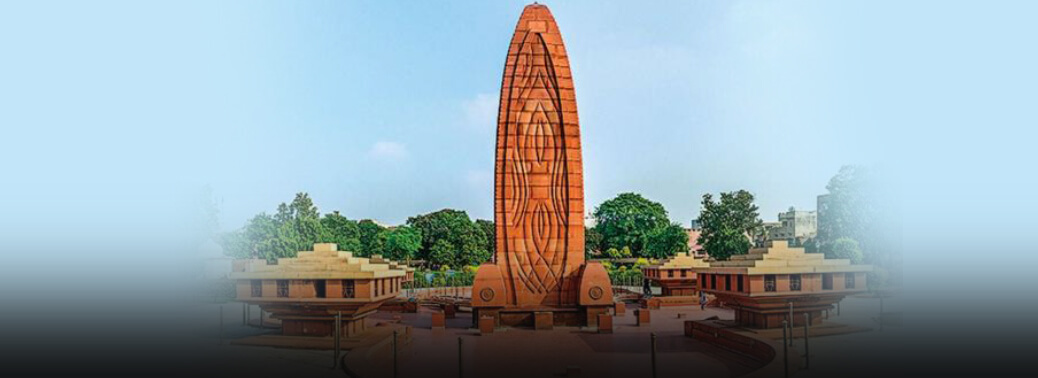
Why in news?
- British high commissioner termed the massacre at Jallianwala Bagh in Amritsar,”a shameful act in British Indian history.
Jallianwala Bagh Massacre:
- An unarmed but large crowd had gathered on 13 April 1919 at Jallianwalla Bagh to protest against the arrest of their popular leaders, Dr. Saifuddin Kitchlew and Dr. Satyapal.
- Jallianwala Bagh (located in Amritsar, Punjab) was a large open space which was enclosed on three sides by buildings and had only one exit.
- General Dyer surrounded the Bagh (garden) with his army until closed the exit with his troops, and then ordered his men to shoot onto the trapped crowd.
- They fired till their ammunition was exhausted. Thousands were killed and wounded.
- After this massacre, martial law was proclaimed throughout the Punjab and the people were submitted to most uncivilized atrocities.
- The Jallianwala Bagh massacre of 1919 in Amritsar as a “shameful scar” on British Indian history. It is also called as Massacre of Amritsar and one of the most tragic yet landmark events in the history of India.
- This massacre exposed the inhuman approach of the British when the British troop cold- bloodedly open fire into an unarmed crowd without any warning by General Dyer which had assembled at enclosed park for the public meeting that was banned.
How many people died in the Jallianwala Bagh Massacre?
- There were no official data on the number of deaths during the Jallianwala Bagh Massacre. But on the official enquiry of the British revealed that there were 379 deaths and the Congress quoted more than 1000 people were died in the massacre.
- Rabindranath Tagore, who had been knighted by the British, renounced his knighthood The massacre marked a turning point in the history of the struggle for freedom.
An ODE to Martyrs of Jallianwala Bagh
13, Apr 2019
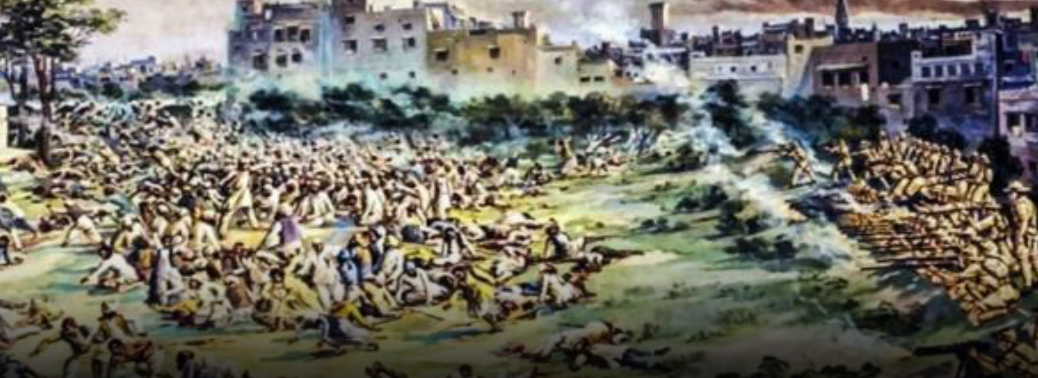
Why in News:
- One of the first poems written in protest after the Jallianwala Bagh massacre of 1919 is being republished to mark the centenary of the tragedy that galvanised the movement for Indian
Background:
- Khooni Vaisakhi, a classic work of protest poetry by the late Nanak Singh, was translated by his grandson Navdeep
- Banned in 1920 by the British after its initial publication, acclaimed Punjabi writer Nanak Singh’s poem on the Jallianwala Bagh massacre has now been translated into English
- Singh was present at Jallianwala Bagh on April 13, He was 22 years old at the time. As the British troops opened fire on the unarmed gathering protesting against the Rowlatt Act, killing hundreds, Singh fainted and his unconscious body was piled up among the corpses.
- After going through the traumatic experience, he proceeded to write “Khooni Vaisakhi”, a long poem that narrates the political events in the run-up to the massacre and its immediate
- The poem was a scathing critique of the British Raj and was banned soon after its publication. Its manuscript was subsequently lost.
- After long years, the poem has been rediscovered and now translated into English by the
- author’s grandson and diplomat, Navdeep Suri.
Jallianwala bagh massacre:
- He situation in Punjab was alarming as there were riots and protests against the Rowlatt Punjab was put under martial law which meant that it became unlawful for more than 4 people to assemble at a place.
- The Lieutenant-Governor of Punjab at that time was Michael O’Dyer. Lord Chelmsford was India’s Viceroy. On the day of the festival of Baisakhi on 13th April 1919 in Jallianwala Bagh, a public garden in Amritsar, a crowd of non-violent protestors had gathered. Also among the crowd were pilgrims who had come to celebrate
- General Dyer came there with his troops and blocked the only narrow entrance to the garden. Then, without warning, he ordered his troops to fire at the unarmed crowd which included children as well. The indiscriminate firing went on for about 10 minutes which resulted in the deaths of at least 1000 people and injured more than 1500
- This tragedy came as a rude shock to Indians and totally destroyed their faith in the British system of National leaders condemned the act and Dyer unequivocally.
- However, Dyer was appreciated by many in Britain and the British in India although some people in the British government were quick to criticise it.
- The government set up the Hunter Commission to inquire into the Although the commission condemned the act by Dyer, it did not impose any disciplinary action against him. He was relieved of his duties in the army in 1920.
- In protest against the massacre and the British failure to give due justice to the victims, Rabindranath Tagore gave up his knighthood and Gandhiji relinquished his title ‘Kaiser-e- hind’ bestowed on him by the British for his services during the Boer War in South
- Michael O’Dwyer, the then Lieutenant-Governor of Punjab, who had approved the actions of Brigadier General Dyer, was assassinated by Udham Singh in London in 1940 as revenge against the Udham Singh is believed to have witnessed the massacre as a child.
BRITAIN’S REFUSAL TO APOLOGISE FOR THE JALLIANWALA BAGH MASSACRE
12, Apr 2019
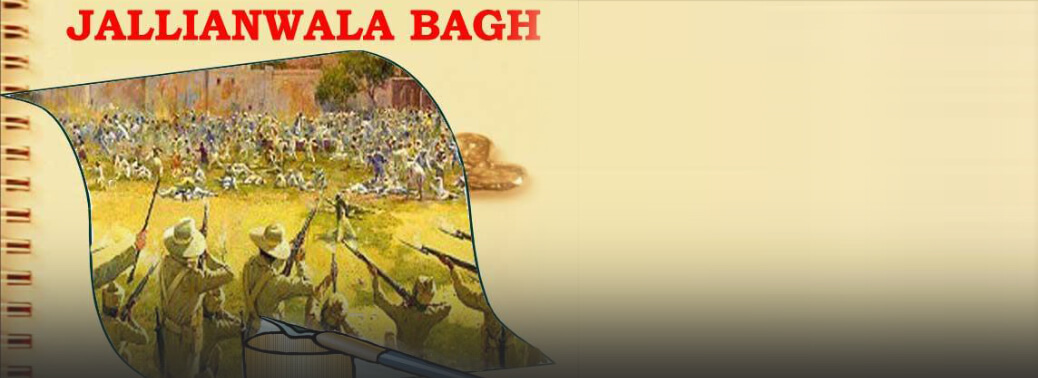
Why in News?
- British apology on the occasion of the centenary of the horrific Jallianwala Bagh massacre, more so since the demand came this time not from Indians alone but also from a strong contingent of British MPs across political parties.
- For Indians, the massacre that evokes strong emotions is not Nader Shah’s slaughter of 30,000 people in Delhi in 1739 but Jallianwala Bagh in Amritsar, where, a century ago, on April 13, troops commanded by General Dyer fired into an unarmed crowd, killing hundreds.
Background:
History:
- Before understanding the Jallianwala Bagh Massacre (JBM) one needs to understand series of events in Indian nationalism in chronology to get better idea:
- Rowlatt act→→JBM→→Non-cooperation movement
Rowlatt Act:
- The Act is passed in Central legislative assembly, despite every Indian member is against the act drafted by Sidney Rowlatt.
- The Act gave the power of imprisoning anyone without proof of conviction and there would be no trial on arrested person.
- Thus, it gagged the Habeas corpus right which is the basic right of civil liberties in Britain. As a protest to act, Gandhiji started Rowlatt satyagraha.
- In fact, Rowlatt satyagraha is the first mass movement of Gandhiji in India.
- As Rowlatt satyagraha caused a wide dissent to British rule, they widely misused the provisions of sedition, muzzling of press and arrest of popular leaders. Some of the places became violent especially Punjab.
Jallianwala Bagh Massacre:
- On 13th April, 1919 people gathered at Jallianwala Bagh (Amritsar) to protest against the arrest of the two nationalist leaders, Satya Pal and Dr Saifuddin Kitchlew. Suddenly, a British military officer, General Dyer, without even giving a warning to the people he ordered his troops to fire at the unarmed crowd for ten minutes till their ammunition was exhausted.
Jallianwala Bagh Massacre: Causes & its Impact
- The Jallianwala Bagh massacre of 1919 in Amritsar as a “shameful scar” on British Indian history. It is also called as Massacre of Amritsar and one of the most tragic yet landmark events in the history of India. This massacre exposed the inhuman approach of the British when the British troop cold-bloodedly open fire into an unarmed crowd without any warning by General Dyer which had assembled at enclosed park for the public meeting that was banned.
- On 13th April people gathered there to protest against the arrest of the two nationalist leaders, Satya Pal and Dr Saifuddin Kitchlew. Suddenly, a British military officer, General Dyer, entered the park with his troops. Without even giving a warning to the people to disperse, he ordered his troops fired at the unarmed crowd for ten minutes and when their ammunition was exhausted, they left. In those ten minutes, according to the estimates of the congress, about a thousand persons were killed and about 2000 wounded. The bullet marks can be still seen on the walls of the Jallianwala Bagh which is now a national memorial.
- The massacre had been a calculated act and Dyer declared with pride that he had done it to produce ‘moral effect’ on the people and that he had made up his mind that he would shoot down all men if they were going to continue the meeting. He had no regrets. He went to England and some Englishmen collected money to honour him. Others were shocked at this act of brutality and demanded an enquiry. A British newspaper called it as one of the bloody massacres of modern history.
- About 21 years later, on 13 March 1940, Udham Singh, an Indian revolutionary, shot Michael O’ Dyer dead who was the Lt. Governor of Punjab at the time of the Jallianwala Bagh massacre. The massacre aroused the fury of the Indian people and the government replied with further brutalities. People in Punjab were made to crawl on the streets. They were put in open cages and flogged. Newspapers were banned and their editors put behind the bars or deported. A reign of terror, like the one that followed the suppression of the revolt of 1857, was let loose.
How many people died in the Jallianwala Bagh Massacre?
- There were no official data on the number of deaths during the Jallianwala Bagh Massacre. But on the official enquiry of the British revealed that there were 379 deaths and the Congress quoted more than 1000 people were died in the massacre.
- Rabindranath Tagore, who had been knighted by the British, renounced his knighthood. In his letter to the viceroy, he declared: “The time has come when the badges of honour make our shame glaring in their incongruous context of humiliation and I for my part wish to stand shorn of all special distinctions, by the side of those of my countrymen, who for their so-called insignificance, are liable to suffer a degradation not fit for human beings”. The massacre marked a turning point in the history of the struggle for freedom.
- In December 1919, the congress session was held at Amritsar. It was attended by a large number of people, including peasants. It was clear that the brutalities had only added fuel to the fire and made the people’s determination stronger to fight for their freedom and against oppression.
Jallianwala Bagh:
- Jallianwala Bagh is a public garden in Amritsar, and houses a memorial of national importance, established in 1951 by the Government of India, to commemorate the massacre of peaceful celebrators including unarmed women and children by British occupying forces, on the occasion of the Punjabi New Year (Baisakhi) on 13 april,1919 in the Jallianwala Bagh Massacre.
NO APOLOGY FOR JALLIANWALA BAGH FOR NOW, SAYS U.K.
10, Apr 2019
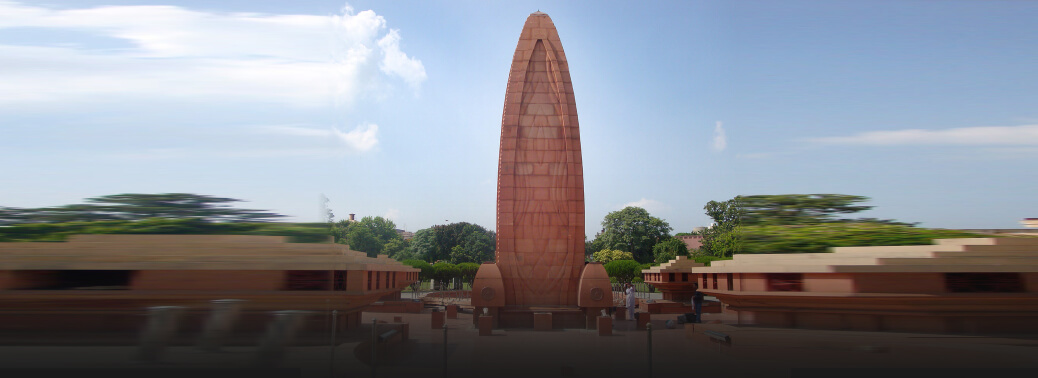
Why in News:
- The British government has refused to apologise for the Jallianwala bagh massacre during a debate in the House of Commons.
Background:
Jallianwala Bagh Massacre
- Gandhiji gave a call for a mighty hartal on 6 April 1919.
- The people responded with unprecedented enthusiasm. The Government decided to meet the popular protest with repression, particularly in the Punjab. It was a Baisakhi day and the people were peaceful, unarmed, most of the crowd was villagers and were not aware that the sarkar has banned the meeting
- An unarmed but large crowd had gathered on 13 April 1919 at Jallianwalla Bagh to protest against the arrest of their popular leaders, Dr. Saifuddin Kitchlew and Dr. Satyapal.
- Jallianwala Bagh (located in Amritsar, Punjab) was a large open space which was enclosed on three sides by buildings and had only one exit.
- General Dyer surrounded the Bagh (garden) with his army until closed the exit with his troops, and then ordered his men to shoot onto the trapped crowd.
- They fired till their ammunition was exhausted.
- Thousands were killed and wounded. After this massacre, martial law was proclaimed throughout the Punjab and the people were submitted to most uncivilized atrocities.
Hunter Committee Report:
- The Jallianwala Bagh massacre was followed by establishment of a non-official enquiry committee by Congress. The British Government did not initiate such inquiry till Congress had set up such committee. Later, the Government established a committee headed by Lord Hunter a Senator of the “College of justice of Scotland”. This committee had 7 members viz. 4 British and 3 Indians
NATIONAL HERALD CASE SUPREME COURT STAYS EVICTION
06, Apr 2019
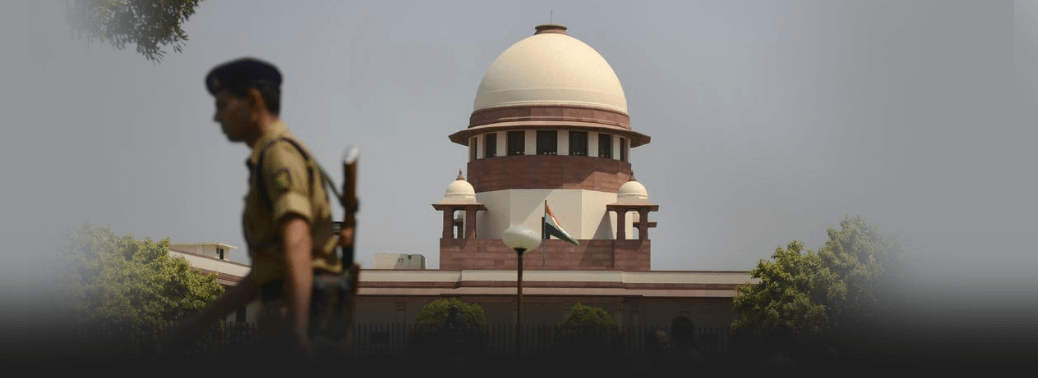
Why in News:
- The Supreme Court on Friday stayed the eviction and further proceedings against Associated Journals Limited (AJL), the publishers of The National Herald Newspaper started by former prime minister Jawaharlal Nehru in 1938.
Details:
- A Bench led by Chief Justice of India Ranjan Gogoi ordered the stay of proceedings against AJL under the Public Premises (Eviction of Unauthorised Occupants) Act, 1971.
National Herald Newspaper:
- It was established by Jawaharlal Nehru in 1938.
- It was published by “The Associated Journals Limited”, a “Section 25” company, which is generally a not-for-profit entity.
- AJL also published the Qaumi Awaz in Urdu and Navjeevan in Hindi.
- The company owns prime real estate in various cities, including Delhi and Mumbai worth around Rs.2000 Cr.
- Veteran Congress leader Motilal Vora has been the chairman and managing director of AJL since March 22, 2002.
What is the case about?
- In 2012 a complaint was filed by BJP leader Subramanian Swamy before the trial court.
- It was alleged that Congress leaders were involved in cheating and breach of trust in the acquisition of Associated Journals Ltd (AJL) by Young Indian Pvt Ltd (YIL), as assets worth crores of rupees had been transferred to YIL. Congress president Sonia Gandhi and vice president Rahul Gandhi are its board of director. Congress treasurer Motilal Vora and general secretary Oscar Fernandes were also named in the case.
What happened?
- AJL ran into losses by overstaffing and a lack of revenue and stopped publishing in April 2008. The Congress party gave the company unsecured, interest-free loans for a few years up to 2010 to keep it afloat. On 2010, a new company called Young Indian Pvt Ltd (YIL) was incorporated as a Section 25 company. By the end of 2010 Rahul Gandhi was appointed as a director of Young Indian. In 2011, Sonia Gandhi joined the board as a director. Motilal Vora and Congress Rajya Sabha member Oscar Fernandes too were appointed to the Young Indian board. As of March 2017, Sonia Gandhi and Rahul Gandhi had shareholdings of 38% each in the company. In 2010, the All India Congress Committee (AICC) decided to let Young Indian recover the Rs.90 crore debt from AJL. Further Young Indian paid only Rs.50 lakh for acquiring all the equities of AJL with all its assets in the country. This is how AJL, which originally owed Rs.90 crore to the Congress party, became a fully-owned subsidiary of Young Indian, which was owned by four individuals —Rahul, Sonia, Vora and Fernandes. Hence Sonia Gandhi and Rahul Gandhi have been alleged of committing fraud and land grabbing by acquiring a publicly limited company (AJL) through their owned private company (YIL).
- The complaint has also alleged that the loan given to AJL was “illegal”, as it had been taken from party funds.
ANNA BURNS WINS MAN BOOKER PRIZE FOR ‘INCREDIBLY ORIGINAL’ MILKMAN
26, Oct 2018

- Why in News?
- Anna Burns has become the first Northern Irish author to win the Man Booker prize, taking the £50,000 award for Milkman, her timely, Troubles-set novel about a young woman being sexually harassed by a powerful man.
Other novels which get Finalised:
- The novels selected for this year’s shortlist reflected a preoccupation with dark times and apocalyptic themes like ecological destruction, slavery and mass incarceration.
- Finalists included the Canadian author Esi Edugyan’s “Washington Black,” about a boy who flees a slave plantation in Barbados and becomes an apprentice of sorts to his master’s adventurous brother; Ms. Kushner’s “The Mars Room,” set in a women’s prison in California; and Mr. Powers’s inventive environmental epic “The Overstory,” about a quest to save one of the world’s last areas of virgin forest, in which the trees are the novel’s real protagonists.
- Judges also recognized unconventional literary forms this year, including, for the first time, a graphic novel by Nick Drnaso, titled “Sabrina,” which made the longlist but was not among the finalists. “The Long Take,” a genre-defying noir-tinged novel in verse by the Scottish poet Robin Robertson that unfolds in verse, prose and photographs, made the shortlist.
About man booker Prize:
- First awarded in 1969, the Booker is one of the literary world’s most prestigious and lucrative prizes. The winner receives 50,000 pounds, or about $65,000, and typically sees a big boost in book sales.
- In 2014, the prize was opened to any novel written in English and published in Britain (it was previously limited to writers from Britain, Ireland, Zimbabwe and Commonwealth countries), and some prominent writers have argued that the rules change has diluted the impact of the prize.
- Fears that the Booker would become “Americanized” were borne out to a degree in recent years, after the prize went to American authors for two consecutive years — to George Saunders in 2017, for “Lincoln in the Bardo,” and to Paul Beatty in 2016, for “The Sellout.” Earlier this year, the Rathbones Folio Academy, a literary society with prominent members such as Margaret Atwood, J.M. Coetzee and Peter Carey, insisted that the change be reversed.
- This year’s crop of finalists included two American novelists, three writers from the United Kingdom and one from Canada.
PM TO UNVEIL PATEL STATUE
23, Oct 2018
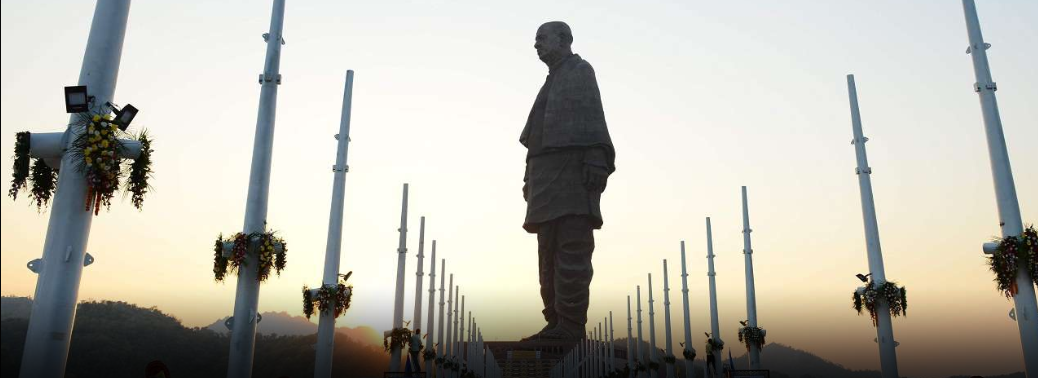
Why in News?
- Prime Minister Narendra Modi is set to unveil Sardar Patel’s statue, the world’s largest, on his birth anniversary on October 31.
About the News:
- Final touches are being given to the Statue of Unity, as it is called, built by engineering and infrastructure major L&T on the river Narmada in South Gujarat. The world’s highest 182-metre statue will get flypast from the Indian Air Force team of Surya Kiran that will display Tricolour in sky when PM will switch on the button to inaugurate the statue.
- The statue has been under construction for nearly four years.
- The Statue of Unity, which is twice the size of the Statue of Liberty, has been built in a remote corner of Gujarat as a flagship project of Modi who is to open it on 31st October.
- The Rs. 3,000 crore projects are funded for the most part by the Gujarat government, with minor contributions from the Centre and Central PSUs.
- This is a tribute to Sardar Patel, who united the country after Independence. It’s a tribute by the nation and the State he was born in.
- The statue is made up of 1,700 tonnes of bronze, 1,850 tonnes of bronze cladding, 70,000 metric tonnes of cement and 24,500 metric tonnes of steel.
- Two high speed elevators inside can take tourists up to the statue’s chest from where around 200 visitors can view the Narmada river and the Sardar Sarovar dam over it.
GOLD FOUND AT KEEZHADI
22, Oct 2018

Why in News?
- The State Department of Archaeology told the Madurai Bench of the Madras High Court that it has applied to the Union Ministry of Culture for starting the fifth phase of the excavations at Keezhadi near Madurai following the completion of the fourth phase.
Background:
- Political controversy has again erupted around Keezhadi (also known as Keeladi), a major archaeological site in Tamil Nadu, four years after excavators began to unearth the remains of an ancient urban civilization that thrived on the banks of the river Vaigai more than 2,000 years ago.
- While delayed allocation of funds and alleged reluctance of the Union government to continue with the excavation led to widespread condemnation in 2016, a year later the transfer of superintending archaeologist K. Amarnath Ramakrishnan led to further protests. The latest round of controversy erupted last week when Ramakrishnan, who is posted in Assam and has submitted an interim report on Keezhadi, was denied permission to write the final report.
- Earlier this year, the Madras high court expressed its displeasure over ASI’s lack of interest in carrying out work at Adichanallur site in Thoothukudi where traces of Iron Age people, whose skeletal remains buried in big urns have been identified.
Phases of Keezhadi Excavation:
- In 2013-14, ASI carried out explorations along the Vaigai river valley in 293 sites in districts of Theni, Dindigul, Madurai, Sivaganga and Ramanathapuram. Keezhadi in Sivaganga was chosen for excavation.
- During the second phase of the excavation, the artifacts unearthed by the team led by Ramakrishnan established a substantial evidence that an ancient urban civilization had thrived on the banks of Vaigai. Last year, carbon dating of charcoal found at the site confirmed that the settlement was from 200BCE.
- More than 8,000 artefacts including pottery with Tamil Brahmi inscriptions, gold coins, beads, iron tools and jewellery, that were unearthed indicated that an urban civilization had existed during the Sangam era — between the 4th century BCE and 2nd century CE that is regarded as a golden era for Tamil language, literature and culture — and that it had trade link with other civilizations including Rome.
- While the third phase was led by ASI, the Tamil Nadu archaeology department after obtaining approval from Central Advisory Board of Archaeology (CABA) began the fourth phase earlier this year.
- Tamil Nadu archaeology department confirmed that the fourth phase is complete with the excavation of more than 7,000 antiques and document preparation is underway.
- The state archaeology department has requested the CABA to permit excavation for the next phase too and will start work by the beginning of next year if approval is granted.
Archaeological Survey of India (ASI):
- The Archaeological Survey of India (ASI) is a Government of India (Ministry of Culture) organisation responsible for archaeological research and the conservation and preservation of cultural monuments in the country. It was founded in 1861 by the British Raj.
- ASI was founded in 1861 by Alexander Cunningham who also became its first Director-General. The first systematic research into the subcontinent’s history was conducted by the Asiatic Society, which was founded by the British Indologist William Jones on 15 January 1784. Based in Calcutta, the society promoted the study of ancient Sanskrit and Persian texts and published an annual journal titled Asiatic Researches. Notable among its early members was Charles Wilkins who published the first English translation of the Bhagavad Gita in 1785 with the patronage of the then Governor-General of India, Warren Hastings. However, the most important of the society’s achievements was the decipherment of the Brahmi script by James Prinsep in 1837. This successful decipherment inaugurated the study of Indian palaeography.
- The Archaeological Survey of India is an attached office of the Ministry of Culture. Under the provisions of the AMASR Act of 1958, the ASI administers more than 3650 ancient monuments, archaeological sites and remains of national importance. These can include everything from temples, mosques, churches, tombs, and cemeteries to palaces, forts, step-wells, and rock-cut caves. The Survey also maintains ancient mounds and other similar sites which represent the remains of ancient habitation.
- The ASI is divided into a total of 29 circles each headed by a Superintending Archaeologist.
WORLD PEACE MONUMENT
22, Oct 2018
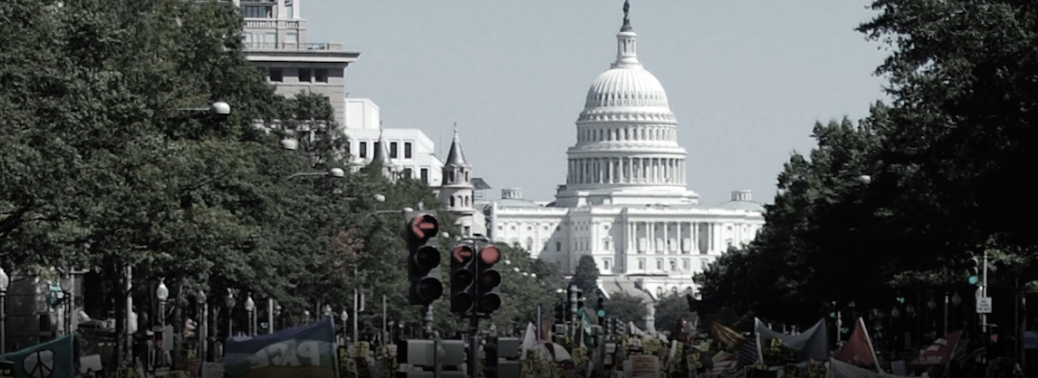
Why in News?
- Vice-President M. Venkaiah Naidu inaugurated the world’s largest dome at the Maharashtra Institute of Technology (MIT)’s World Peace University (MIT-
WPU) campus at Loni Kalbhor on the occasion of the 150th birth anniversary of Mahatma Gandhi.
Background:
- Institute authorities have said the structure, called the ‘World Peace Monument’ dome, took nearly 13 years to build. At 160 ft in diameter and 263 ft tall, it is larger in area than the dome at St. Peter’s Basilica in Vatican City (which is 136 ft. in diameter and 448 ft. in height).
- It is the outcome of 13 years of sheer dedication and untiring efforts against all odds by a teacher, Dr. Vishwanath Karad, who was deeply inspired by the teachings of apostles, saints, philosophers and scientists down the ages. He said that the world is one family – ‘Vasudhaiva Kutumbakam’ – which is an ancient Indian concept and it is a humble attempt to create an edifice befitting the glory of Mother India
- It is supported by 24 massive columns, each 63 feet tall, at the periphery of the dome and underneath — inside and outside — stand imposing bronze statues of 54 of the biggest names in world history stand, irrespective of nationality or religion002E
- Among the statues are: Gautam Buddha, Jesus Christ, Mahavir, Moses, Guru Nanak and Mahatma Gandhi; intellectual giants like Confucius, Adi Shankaracharya, Aristotle, Aryabhatta, Socrates, Plato, Galileo and Copernicus; philosopher-saints like Dnyaneshwara, Tukaram, Abdullah Shah Qadri (famous as Baba Bulleh Shah), Francis D’Assissi, Peter, Mother Teresa and Kabir; and scientists like Albert Einstein, Thomas Alva Edison, C.V. Raman, Jagadish Chandra Bose and Marie S. Curie.
5000-YEAR-OLD ROCK PAINTINGS – ANJUKULIPATTI PAINTINGS
21, Oct 2018
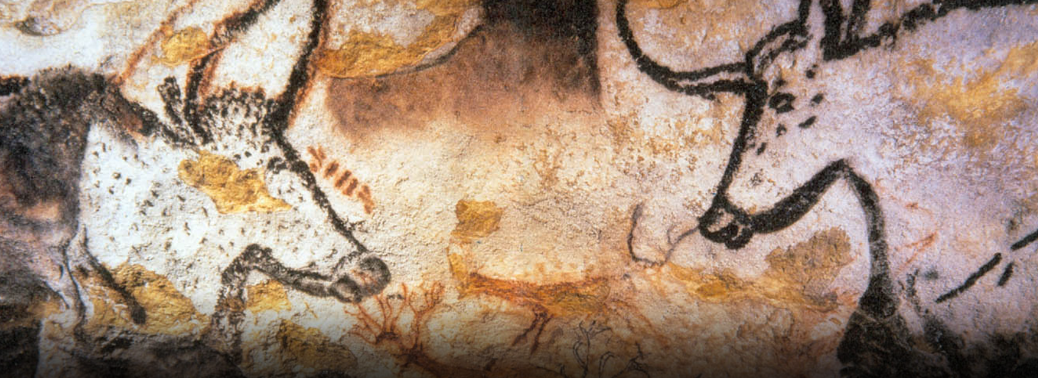
In News:
- For centuries, the fear of curse and death prevented the local people from visiting Ezhuthuparai (rock with writings and paintings) in
- Anjukulipatti on the Natham-Dindigul Road.
Background
- Believed to have been drawn between 3,000 and 3,500 BCE.Researchers spotted a panel of rock paintings belonging to a period between 3,000 BCE and 3,500 BCE.
- They are white in colour and the paintings are drawn using lime pigment mixed with animAal fat
- The panel has 56 paintings depicting tridents, spears, swords, horse and elephant riders, sacrifice of animals, mantras on energy and food, and lots of symbols.
- Though there are other paintings, they are in bad shape and cannot be deciphered.
- There are scenes either from a hunting expedition or a war. Similar paintings have been found in Sirumalai and the area is also a continuation of Sirumalai, though unexplored so far, He added that one important finding in the panel was a painting of sexual intercourse and a similar painting was found in Mallapadi in Dharmapuri district. Moreover, the human beings looked bulkier than they were in similar paintings found elsewhere.
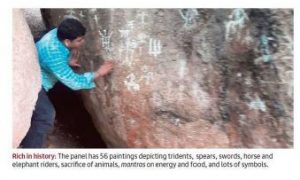
Other Rock paintings
- Bhimbetka Caves, Foothills of Vindhya, Madhya Pradesh. One of the oldest paintings in India and the world (Upper paleolithic).
Jogimara caves, Amarnath, Madhya Pradesh.
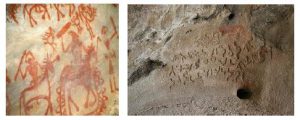
75th ANNIVERSARY OF AZAD HIND GOVERNMENT
20, Oct 2018
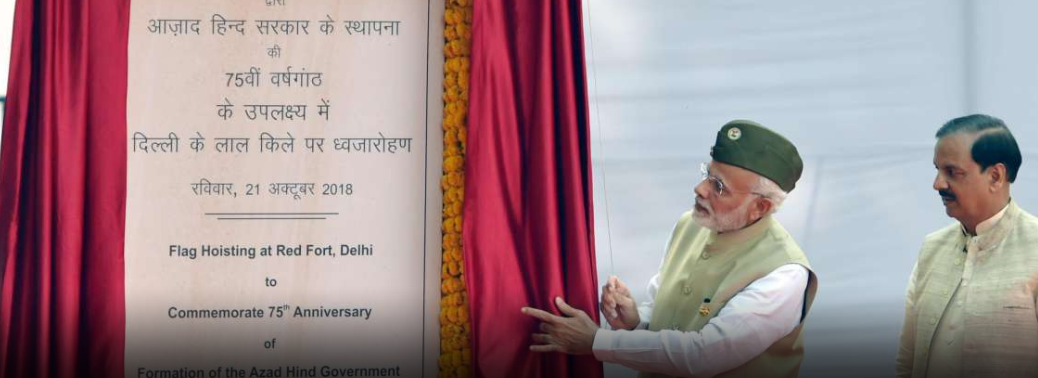
- Union government is to celebrate the 75th anniversary of the formation of Azad Hind Government on 21st October, 2018, at the Red Fort, Delhi by hoisting the National flag and unveiling the plaque.
- Traditionally, the prime minister hoists the national flag at the Red Fort on Independence Day.
- The prime minister will also lay the foundation stone of a museum dedicated to the Azad Hind Fauj.It is located in special barrack of the Red Fort where Indian National Army soldiers faced trials by British authorities
- The Azad Hind Government, founded on 21st October, 1943 was inspired by Neta ji Subhash Chandra Bose who was the leader of Azad Hind Government and also the Head of State of this Provisional Indian Government-in-exile. It was a part of the freedom movement, originating in 1940s outside India with a purpose of allying with Axis powers to free India from British rule. The existence of the Azad Hind Government gave a greater legitimacy to the independence struggle against the British.
- Pertinently, the role of Azad Hind Fauj or the Indian National Army (INA) had been crucial in bequeathing a much-needed impetus to India’s struggle for Independence.
- Although it was short-lived, some historians consider it an important milestone in India’s journeys to independence.
Background:
Global Language Park
11, Sep 2018
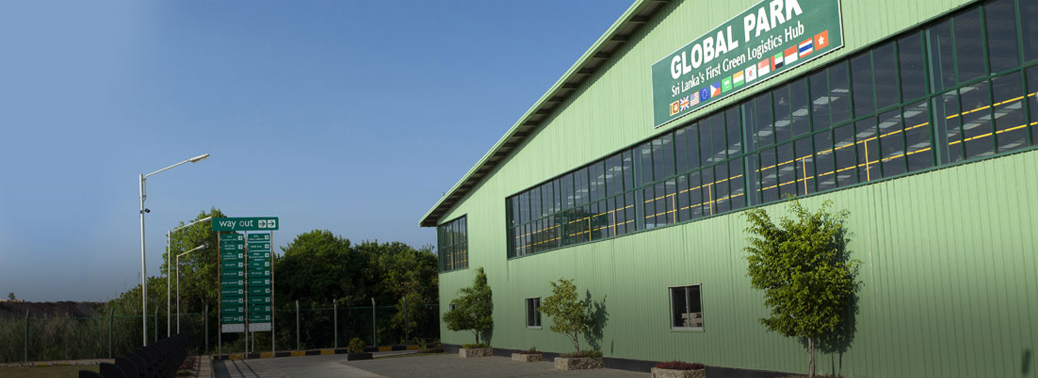
Why in News?
- A Global Language Park in Pune will celebrate and promote linguistic diversity.
About the news:
- The first such experiment in the country, and perhaps the world, the eminent linguist Ganesh Devy plans to setup a Global Language Park (bhasha van in Hindi) in Pune.
- It will be located on a one-acre plot on the premises of the Savitribai Phule Pune University (SPPU).
- Conceptualised as part of the 84th PEN(Poets, Essayists, Novelists)International Congress that is under way in the city, the park will have about 80 ‘language trees.’
- Akin to the concept of a language tree in English grammar, each of the 80 trees will symbolise a major or minor language tree sprouting from the important language families.
- Each tree represents the languages and dialects derived from the family or parent tree, explaining the connection between natural trees and languages in the Linguists estimate that the world has more than 140 language families, each with its member-languages and dialects.
- Set to open in January 2019, the park will have a tree-lined walkway. Each plant will be equipped with a ‘bespoke audio tour’ to aid visitors. Audio samples of songs, poems, folk tales, sayings, and jokes will be drawn from different world languages.
Kartarpur Sahib Corridor
06, Sep 2018
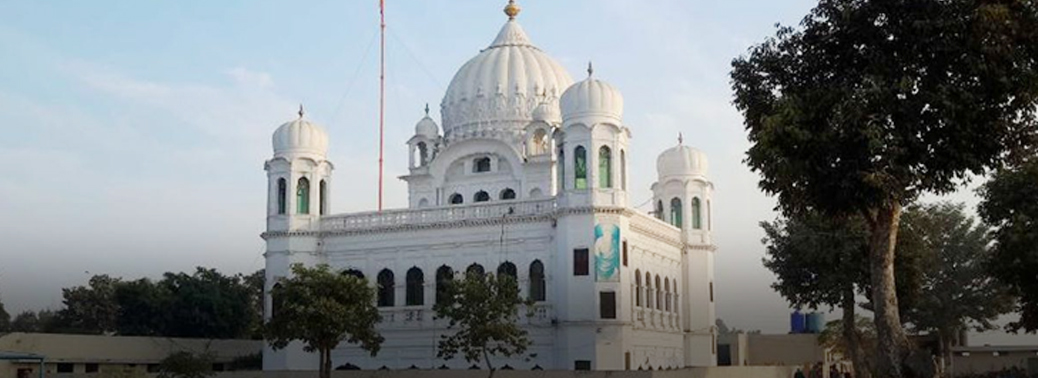
- The Sikh community has been lobbying for the Kartarpur sahib corridor that would allow Indian pilgrims to travel to the shrine located in Pakistan Lahore without a visa.
- It is built on the historic site where Guru Nanak settled and assembled a Sikh community after his missionary travels. The present gurdwara is built on the site where Guru Nanak died.
Virtual visit to Indian Museum
05, Sep 2018
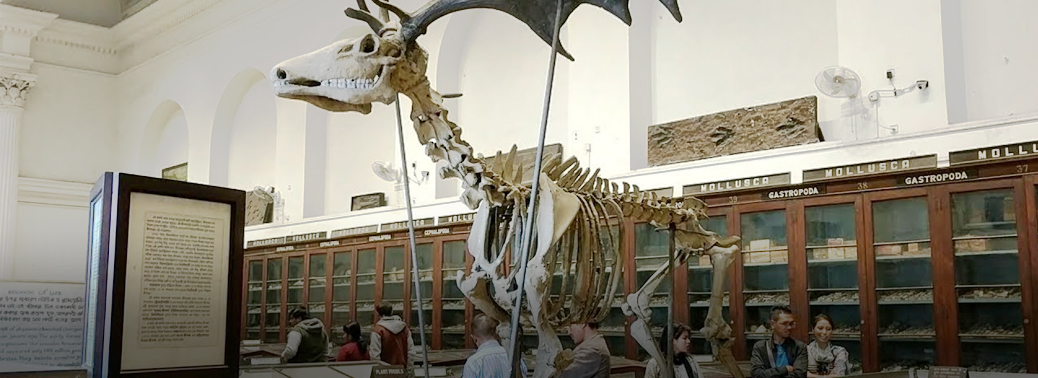
Why in news?
- Museum enthusiasts can now admire the rare collections of jewels, antiques, fossils, andbiological specimens in India’s oldest and biggest museum without stirring out of their homes.
Background:
- The initiative, titled ‘Online Exhibition: Rare & Precious Antiques from Indian MuseumKolkata Collection’, has over 40 artefacts, with photographs and captions explaining their significance. These include, among others, an emerald bow ring of Shah Jahan, a golden goblet studded with precious stones that belonged to Jehangir, a terracotta vase from Baluchistan dating back to 4,000-3,000 BCE, and a third century crystal casket that is said to have contained the relics of the Buddha.
- The artefacts are priceless. There is a need to display them with a lot of caution, under strong security surveillance. Until there makes to upgrade our security, the digital interface provides us an opportunity to make more people aware of the collection.
Indian Museum Kolkata:
- Founded in 1814 at the cradle of the Asiatic Society of Bengal (at the present building of the Asiatic Society, 1 Park Street, Kolkata), Indian Museum is the earliest and the largest multipurpose Museum not only in the Indian subcontinent but also in the Asia-Pacific region of the world.
- With the foundation of Indian Museum in 1814, the Museum movement started rolling in India and through the years from then, got a new fillip and great momentum. Since then, it has so magnificently developed and culminated into the fruitful existence of more than 400 museums in the country.
J & K artists Weave life back into Antique shawl
05, Sep 2018
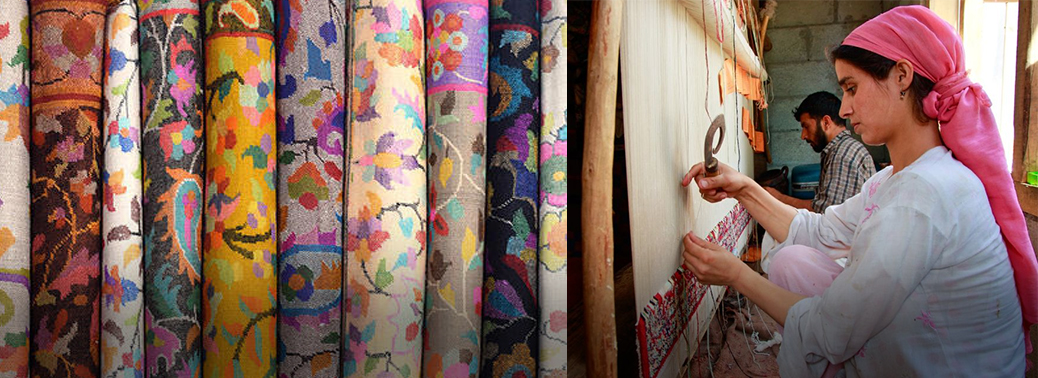
Why in news?
- The Jammu & Kashmir government is now making efforts to revive this dwindling breed of craftsmen whose rare ability to repair expensive antique shawls is in great demand across the country and abroad.
Rafoogars:
- Rafoogars of India, who are specialists in Textile restoration and The darning has to be so beautiful that it has to merge with the cloth, the damage becoming invisible. It is perfection not visible.
- Darners from Kashmir once impressed the Mughal emperors, who hired them to keep their shatoosh and pashmina shawls intact.
- This exhibition aims to highlight their important role in the preservation, restoration and renewal of these precious shawls by recognising the highly intricate and laborious work.
Shatoosh shawl:
- Shahtoosh shawls are so fine and light they can be passed through a wedding ring and are warm enough to hatch a pigeon egg. Its name was given by the Mughal Emperors and it means “king of wools” in Persian.
- It is made of the exceptionally fine underfur of the Tibetan antelope or chiru, which insulates this rare animal against the harsh climate of the Tibetan plateau.
- The antelope must be killed for the fur to be collected, and it takes around 4 chiru to make a single shawl.
- Woven by highly skilled Kashmiri artisans, Shahtoosh shawls are a status symbol in India and Pakistan and one of the most valuable dowry gifts a person can However, processing or wearing shahtoosh is a punishable offence in these countries and anyone selling them face prison sentences of up to two years and fine.
- International trade in the Tibetan antelope is also banned under the Convention on International Trade in Endangered Species (CITES).
- According to Wold Wildlife Fund(WWF), the population of chiru is estimated to have declined by more than 50% during the last 20 years of the 20th century.
Pashmina shawl:
- Pashmina is a fine type of Kashmiri wool. The textiles made from it were first wovenin Kashmir. The name comes from Persian meaning “made from wool” and literally translates to “Soft Gold” in Kashmiri.
- The wool comes from four distinct breeds of the Cashmere goat; namely the Changthangi or Kashmir Pashmina goat from the Changthang Plateau in Kashmir region, the Malra from Kargil area in Kashmir region, the Chegu from Himachal Pradesh in northern India, and Chyangara or Nepalese Pashmina goat from Nepal.
- These shawls are hand spun, and woven in Kashmir and Nepal, and made from fine cashmere fibre.
MAQOM Art Inter’L Forum
05, Sep 2018
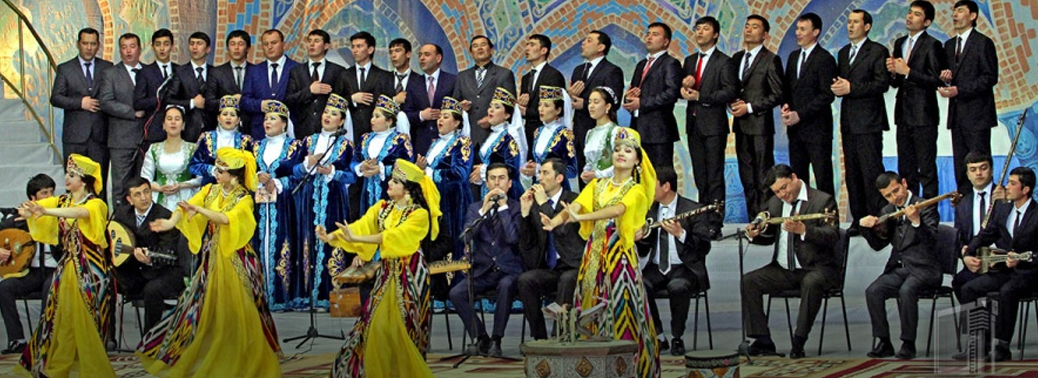
Indian vocalist wins second prize in the Maqom Art International Forum in Uzbekistan
About:
- Ustad Iqbal Ahmed Khan from India won second prize worth of USD 7000 for his performance in the solo category in the first Maqom Art International Forum in Shakhrisabz city of Uzbekistan this month.
- Serving the Indian Classical Music for more than 50 years, vocalist Ustad Iqbal Ahmed Khan from Delhi Gharana is well known for his versatility and solid vocal expression.
- His expertise in a number of forms of music like Khayal, Thumris, Dadras, Bhajans, and Ghazals makes his range very wide. His style of classical singing has won him great acclaim. He is a recipient of the Sangeet Natak Akademi Award for his contribution to classical music, known as the khalifa or head of the Dilli gharana of Hindustani music.
Background:
- The international forum is organized on the initiative of the President of Uzbekistan Shavkat Mirziyoyev to broadly promote the Oriental Maqom art, affirm respect among the younger generation and increase interest in national classical music.
- More than 300 international guests from 71 countries of the world visited Shakhrisabz to take part in the event. Among them 162 maqom performers participated in the festival that was covered by journalists from 30 countries.
- The forum itself was preceded by large-scale preparations in the form of various exhibitions, academic round tables dedicated to maqom.
- Scientific-practical conference on the topic “Music art of maqom and its role in the world civilization”
- Various exhibitions dedicated to maqom, showcases and sales of national musical instruments, textiles, handicrafts, works of fine and applied art, sculpture, art and plays of documentary films, books and albums were organized on Oqsaroy square in Shakhrisabz.
- This event will be held every two years. The coordination is in the hands of the Ministry of Culture of Uzbekistan, the Uzbek National Center of the Maqom Art, other stakeholders. The Forum is held under the patronage of UNESCO.
- It is to popularize widely one of the famous genres of classical and musical art of East people, to preserve maqom culture contemporarily with modern life, learn and investigate them, develop and encourage professional maqom performers and support them.
- Expand public attitude of youth to maqom art in generation’s soul, to perform rich, artistic and esthetic opportunities of musical heritage, strengthen relations of friendship between nations regularly.
- Encompass Uzbek maqom and music genres of East people, exchange cultural-scientific information, make scientific and creative cooperation, expand cultural and spiritual relations.
Guru Fete
09, Aug 2018
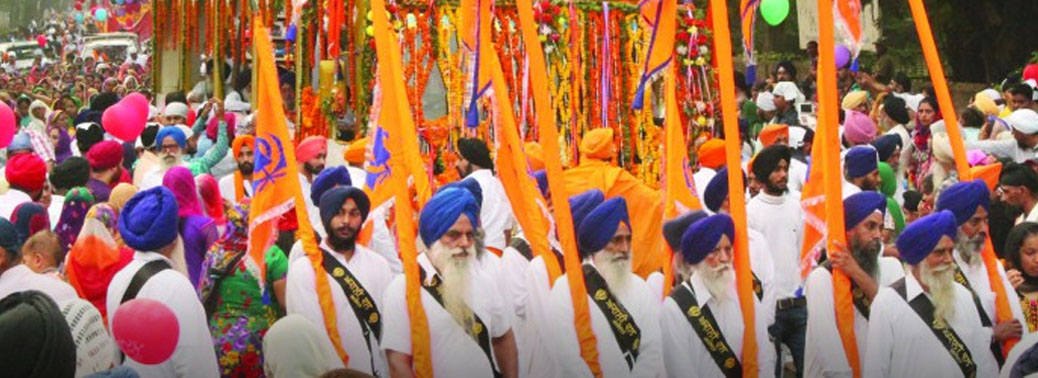
- External Affairs Minister Sushma Swaraj announced that all Indian diplomatic missions would celebrate the 550th birth anniversary of the founder of Sikh faith Guru Nanak.
About:
- Indian diplomatic and cultural missions across the world will organise prayers and festivities to mark the 550th birth anniversary of Guru Nanak.
- The move is seen as a counter to the pro-Khalistan rally in London.
- To take the message of Guru Nanak to the world. His message of sharing the fruits of good deeds with all is the right teaching in this era when I, me, myself is the dominating idea.
- The message of One God taught by Guru Nanak is similar to the Indian teaching in the Shastras.
- Guru Granth Sahib is the best representative of the Indian understanding of multiple versions of truth. Guru Granth Sahib is the only holy book in the world which apart from the ten gurus of Sikh faith also contains messages (vaanis) of other learned saints and great souls (belonging to other faiths).
Pro-Khalistan Rally:
- A pro and an anti-Khalistan rally took place in central London on Sunday
- In a rally at the Trafalgar Square, for the support of a non-binding referendum in 2020, dubbed the London Declaration, for an independent Sikh nation.
- The group was organised by the US-based group Sikhs for Justice, though the rally attracted demonstrators from across the UK.
- The rally has drawn the ire of the Indian government, which has called it a ‘separatist activity, which impinges on India’s territorial integrity.
- Pro-Khalistan groups based out of India, have refused to support the referendum and instead, have asked searing questions of the campaign and its effectiveness.
Guru Nanak:
- Guru Nanak (15 April 1469 – 22 September 1539) was the founder of Sikhism and the first of the ten Sikh Gurus.
- Guru Nanak’s words are registered in the form of 974 poetic hymns in the holy text of Sikhism, the Guru Granth Sahib.
- Guru Nanak travelled far and wide teaching people the message of one God who dwells in every one of His creations and constitutes the eternal Truth.
- He set up a unique spiritual, social, and political platform based on equality, fraternal love, goodness, and virtue.
- Guru Nanak emphasised Bhakti, and taught that the spiritual life and secular householder life are intertwined.
- Guru Nanak emphasised Nam Japna (or Naam Simran), that is repetition of God’s name and attributes, as a means to feel God’s presence.
- Guru Nanak appointed Bhai Lehna as the successor Guru, renaming him as Guru Angad, meaning “one’s very own” or “part of you”. Shortly after proclaiming Bhai Lehna as his successor, Guru Nanak died on 22 September 1539 in Kartarpur, at the age of 70.
Railways To Mark Gandhi’s 150th Birth Anniversary
06, Aug 2018

- All coaches of the Indian Railways will now display the logo of the government’s pet project Swachch Bharat and the national flag as part of the national transporter’s plans to celebrate the 150th birth anniversary of Mahatma Gandhi.
- The Railway Board has said that the ‘Swachchta Pakhwara’ from September 15-October 2, would mark the beginning of the railways’ plans to commemorate Gandhi’s birth anniversary.
- It has identified 43 stations with special association with Mahatma Gandhi which will be painted thematically while 28 others near iconic places would undergo massive cleanliness drives.
- The board has also picked up themes for the next six months starting October 2018 – sanitation, non-violence, voluntary community service, communal unity, removal of untouchability, and women empowerment.
- Instructions have also been sent out to plant trees along railway tracks and get both serving and retired railway personnel along with passengers to participate in ‘Shram Daan’.
- The board has said, should be given on the cleanliness of approaches to golden triangle region- to and from Delhi, Agra and Jaipur.
- It has also said that administrative offices – zonal and divisional headquarters – should have “murals of Gandhiji with his quotes”.
- October 2 this year has been set as a deadline for completion of these activities.
Behdienkhlam Festival
24, Jul 2018
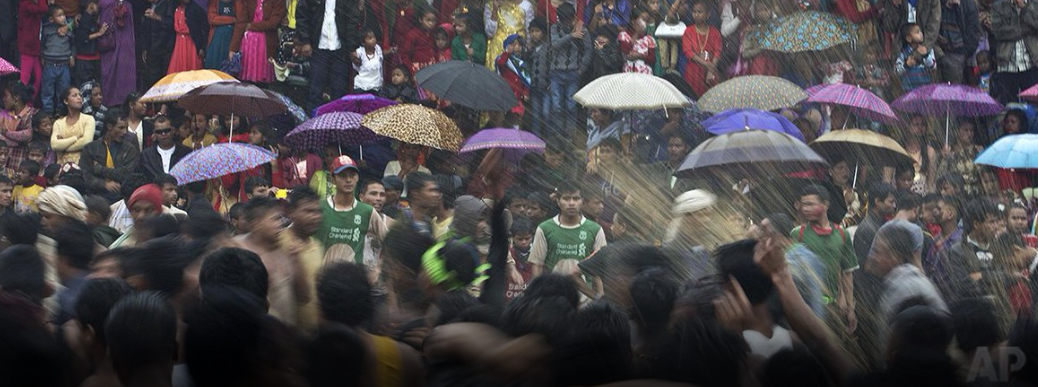
It is the most important festival of the Jaintias or Pnar tribal community in meghalaya and is celebrated mid-July every year after the sowing is over.
“Khlam” means plague or pestilence’and “beh dien” means to drive away with sticks.
Is the ritualistic expression of the relentless struggle of mankind to overcome the destructive forces of nature, including diseases, since the dawn of civilization. This festival is also an invocation to God seeking blessings for a good harvest.
This festival is celebrated around the same time “Rath Yatra” is celebrated in other parts of eastern India. Behdienkhlam Festival is the most celebrated religious festival among the Pnars. It is popular at Jowai the District headquarters of Jaintia Hills District, Meghalaya.
The central government is funding this festival to promote tourism, said organizing President.
BRU Tribes:
An agreement has been signed by Government of India, Governments of Mizoram and Tripura and Mizoram Bru(Reangs) Displaced People’s Forum (MBDPF). To repatritate BRU people who is in temporary camps in Tripura to their native lands in Mizoram.
Background:
The Young Mizo Association and Mizo Zirlai Pawl, or the Mizo Students’ Association, organisations wanted more political autonomy for Mizoram’s Brus, and demanded a Bru Autonomous District Council. In 1997, militants of the Bru National Liberation Front allegedly shot down a Mizo forest guard at the Dampa Tiger Reserve located in Mamit district. The incident evoked a hostile reaction, and the Brus were at the receiving end of a violent backlash by the Mizos, forcing the Brus to flee the state in large numbers to neighbouring Tripura.
BRU Community:
- The Brus, also referred to as the Reangs, are spread across the northeastern states of Tripura, Assam, Manipur, and Mizoram.
- Agriculture is main occupation, they practice jhum cultivation.
- Mostly follow Hinduism.
- They speak the Reang dialect of kokborak language which is of Tibeto-Burmese origin and is locally referred to as Kau Bru.
Swadesh Darshan Scheme
15, Jul 2018

Ministry of Tourism launched the Swadesh Darshan Scheme a Central Sector Scheme for integrated development of theme based tourist circuits in the country. It develop tourism related infrastructure and service in selected area.
Scheme Objectives:
- To position tourism as a major engine of economic growth and job creation.
- Develop circuits having tourist potential in a planned and prioritized manner.
- Promote cultural and heritage value of the country to generate livelihoods in the identified regions.
- Enhancing the tourist attractiveness in a sustainable manner by developing world class infrastructure in the circuit /destinations.
- Follow community based development and pro-poor tourism approach.
- Creating awareness among the local communities about the importance of tourism for them in terms of increased sources of income, improved living standards and overall development of the area.
- To create employment through active involvement of local communities.
- Harness tourism potential for its effects in employment generation and economic development.
- To make full use of the potential and advantages in terms of available infrastructure, national culture and characteristic strong points of each and every region throughout the country by development of theme based circuits.
- Development of tourist facilitation services to enhance visitor experience/satisfaction.
Funding:
- The Scheme is 100% centrally funded and efforts are made to achieve convergence with other schemes of Central and State Governments and also to leverage the voluntary funding available for Corporate Social Responsibility(CSR) initiatives of Central Public Sector Undertakings and Corporate Sector.
- Suitable Public Private Partnerships to be taken up for improved sustainability of the projects.
- A Special Purpose Vehicle (SPV) may be created for the purpose, wherever feasible.
- At present the duration of Swadesh Darshan Scheme is till the 14th Finance Commission Period i.e. March 2020.
Ramayana Express
10, Jul 2018
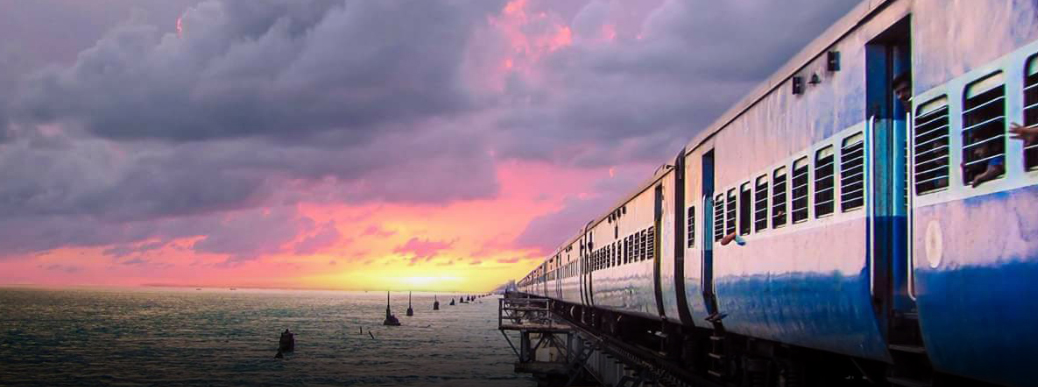
- The Indian Railways is introducing a special tourist train which will visit places associated with Hindu epic Ramayana.
- The Shri Ramayana Express will commence in New Delhi and travel from Ayodhya to Rameswaram.
- Tour package also includes destinations in Sri Lanka. Those who wish to continue the tour after Rameswaram will have to fly to Colombo from Chennai.
- Ramayana Circuit is one among the thirteen thematic circuits identified for development under Swadesh Darshan Scheme.
- There are15 destinations in the Ramayana Circuit in an effort to promote religious tourism. The destinations are chosen according to the places where Lord Ram is believed to have travelled across India www.modernpropertysolutions.com.
- The 15 destinations are — Ayodhya, Shringverpur and Chitrakoot in Uttar Pradesh, Sitamarhi, Buxar and Darbhanga in Bihar, Chitrakoot in Madhya Pradesh, Nandi gram in West Bengal, Mahendragiri in Odisha, Jagdalpur in Chhattisgarh, Bhadrachalam in Telangana, Rameswaram in Tamil Nadu, Hampi in Karnataka and Nashik and Nagpur in Maharashtra.
- By Swadesh Darshan Scheme, destinations under the circuit will be developed by bridging infrastructural gaps like provision of drinking water, accommodation facilities, etc. Then the 15 places will be connected to form a circuit.
UNESCO World Heritage site
02, Jul 2018
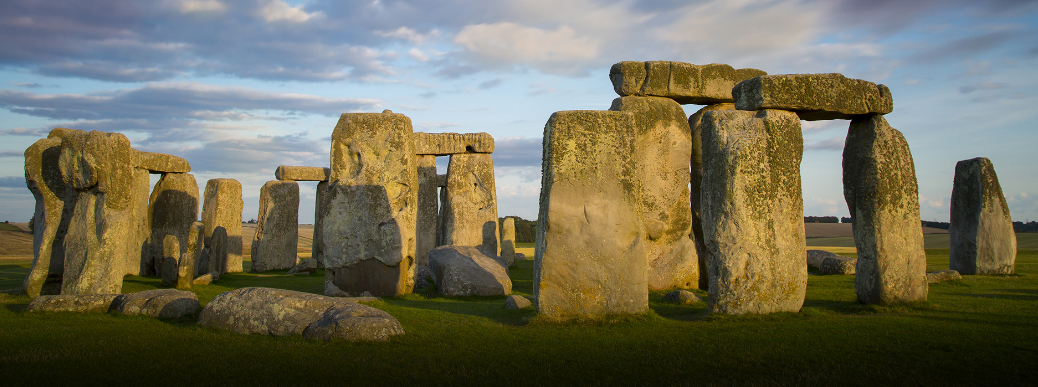
- Mumbai’s Art Deco buildings from India is added to UNESCO World Heritage Sites.
- Mumbai’s Art Deco buildings, it ensembles bear testimony to the phases of modernization that Mumbai has undergone in the course of the 19th and 20th centuries.
Other sites in Maharashtra are:
- Ellora caves
- Ajanta caves
- Elephant caves
- Chhatrapati Shivaji Maharaj Terminus
- Western Ghats
India now houses totally 37 UNESCO World Heritage sites.
UNESCO World Heritage Site:
Is a landmark or area which is selected by the UN Educational, Scientific and Cultural Organization (UNESCO)as having cultural, historical, scientific or other form of significance, and is legally protected by international treaties download from collectiveray.
It came by Convention Concerning the Protection of the World Cultural and Natural Heritage signed by UNESCO members.
It establish World Heritage Committee comprises of 15 State parties to convention.
Procedure
- Every State Party to this Convention shall, in so far as possible, submit to the World Heritage Committee an inventory of property forming part of the cultural and natural heritage, situated in its territory
- A country must first list its significant cultural and natural sites; the result is called the Tentative List.
- Next, it can place sites selected from that list into a Nomination File.
- The Nomination File is evaluated by the International council on monuments and sites and the World Conservation Union.
- These bodies then make their recommendations to the World Heritage Committee. The Committee meets once per year to determine whether or not to inscribe each nominated property on the World Heritage List and sometimes defers or refers the decision to request more information from the country which nominated the site.
Selection Criteria
Cultural criteria:
- Represents a masterpiece of human creative genius and cultural significance.
- Exhibits an important interchange of human values, over a span of time, or within a cultural area of the world, on developments in architecture or technology, monumental arts, town-planning, or landscape design.
- To bear a unique or at least exceptional testimony to a cultural tradition or to a civilization which is living or which has disappeared.
- Is an outstanding example of a type of building, architectural, or technological ensemble or landscape which illustrates a significant stage in human history.
- Is an outstanding example of a traditional human settlement, land-use, or sea-use which is representative of a culture, or human interaction with the environment especially when it has become vulnerable under the impact of irreversible change.
- Is directly or tangibly associated with events or living traditions, with ideas, or with beliefs, with artistic and literary works of outstanding universal significance.
Natural criteria:
- Contains superlative natural phenomena or areas of exceptional natural beauty and aesthetic importance.
- Is an outstanding example representing major stages of Earth’s history, including the record of life, significant on-going geological processes in the development of landforms, or significant geomorphic or physiographic features.
- Is an outstanding example representing significant on-going ecological and biological processes in the evolution and development of terrestrial, fresh water, coastal and marine ecosystems, and communities of plants and animals.
- contains the most important and significant natural habitats for in-situ conservation of biological diversity, including those containing threatened species of outstanding universal value from the point of view of science or conservation.
List of World Heritage in Danger:
A site may be added to the list of heritage site in danger if there are conditions that threaten the characteristics for which the landmark or area was inscribed on the World Heritage List. Such problems may involve armed conflict and war, natural disasters, pollution, poaching, or uncontrolled urbanization or human development.
Manas National park and group of Monuments at Hampi once listed in World heritage in danger, later it was removed by proper conservation.






